KNOW YOUR NATIVE (INDIAN TRIBE)
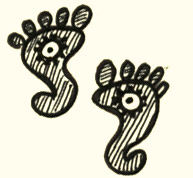
The distinctly peculiar characteristics of indigenous Indian Tribal communities have always been found fascinating, whether one has come across them virtually or physically. They not only add to the diversity of our country but also brings back the historical significance of tribes which remain untouched by the wave of westernisation. In order to preserve and celebrate our native Indians, Gaatha brings you Know Your Native, where we help you join hands with various different tribal communities in India and distinguish one tribe from another by understanding their culture, ornamentation, clothing, hairstyles and other various practices.
CHAKHESANG
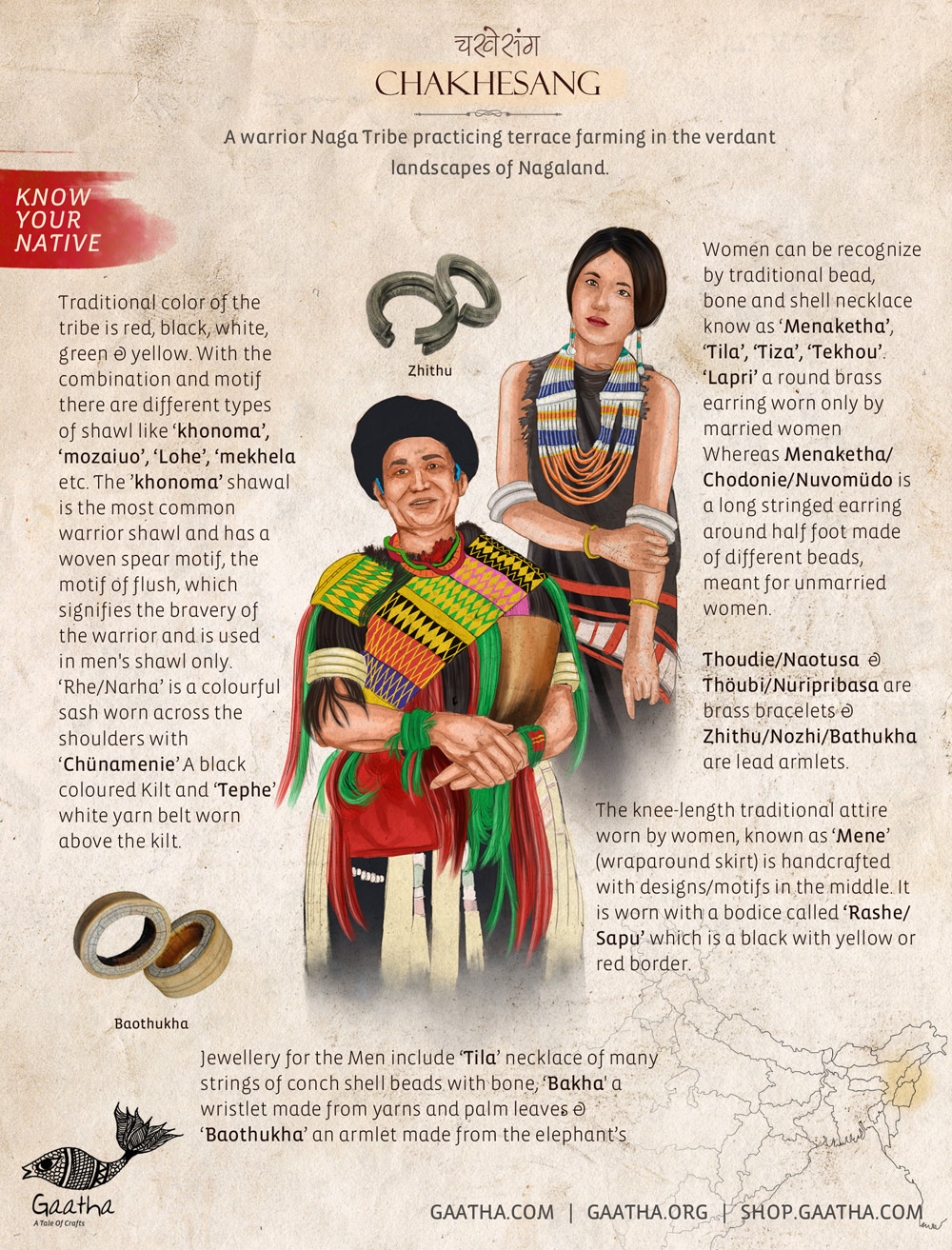
Chakhesang
Chakhesang is one of the biggest tribes among Nagas and are known as the ‘Eastern Angamis’ after their separation from the original Angami tribe and settling down in the eastern part of Nagaland. The tribe is further divided into two groups known as ‘Chokri’ and ‘Khezha’. The name ‘Chakhesang’ was created as an acronym from the names of three tribes: the Chokri, the Khezha, and the Sangtam (now known as Pochury).
The myth of their origin holds that themia (man), tekhu (tiger) and ruopfü (spirit) were the sons of the same mother. Upon her death, the three brothers became estranged, and Kepenuopfü (the birth spirit) is generally held to be in spirit form living in the sky.
Chakhesang highly revere their ancestors. The memorials/graves of the war heroes are frequently surmounted by life-size wooden effigies, which the souls are said to inhabit temporarily. Ornaments and beads are offered to the effigy rather than to the grave.
Historically a warrior tribe, the Chakhesangs now lead a life of settled agriculturalists and practice both terrace and wet paddy field cultivation. They are also considered as the best terrace makers. Hunting among the Chakhesangs has been an important part of the culture. Even the festivals are linked with hunting practices.
They celebrate seven festivals in a year and all of the festivals are based on their agricultural cycles.
Chakhesangs are especially noted for their amazing wood carving and bamboo weaving skills.Their handicrafts include wood carved building fronts & gates with Mithun horns, blacksmithing, pottery, & weaving. Along with cotton, unconventional materials like Nettle plant, Deccan jute and bark of Debrege tree are woven on a loin loom or body tension looms to create the ‘Chi Pi Khwü’- shawls that constitute their identity.
Even their traditional jewellery is worn according to social status. Traditionally, a ‘Tiza’ (Nacklace) is a girl’s prized possession. On attaining puberty, it is gifted to the daughters by their mothers. The number of strands and qualit of the Tiza denotes wealth and status the girl would be bestowed with.
KHASI
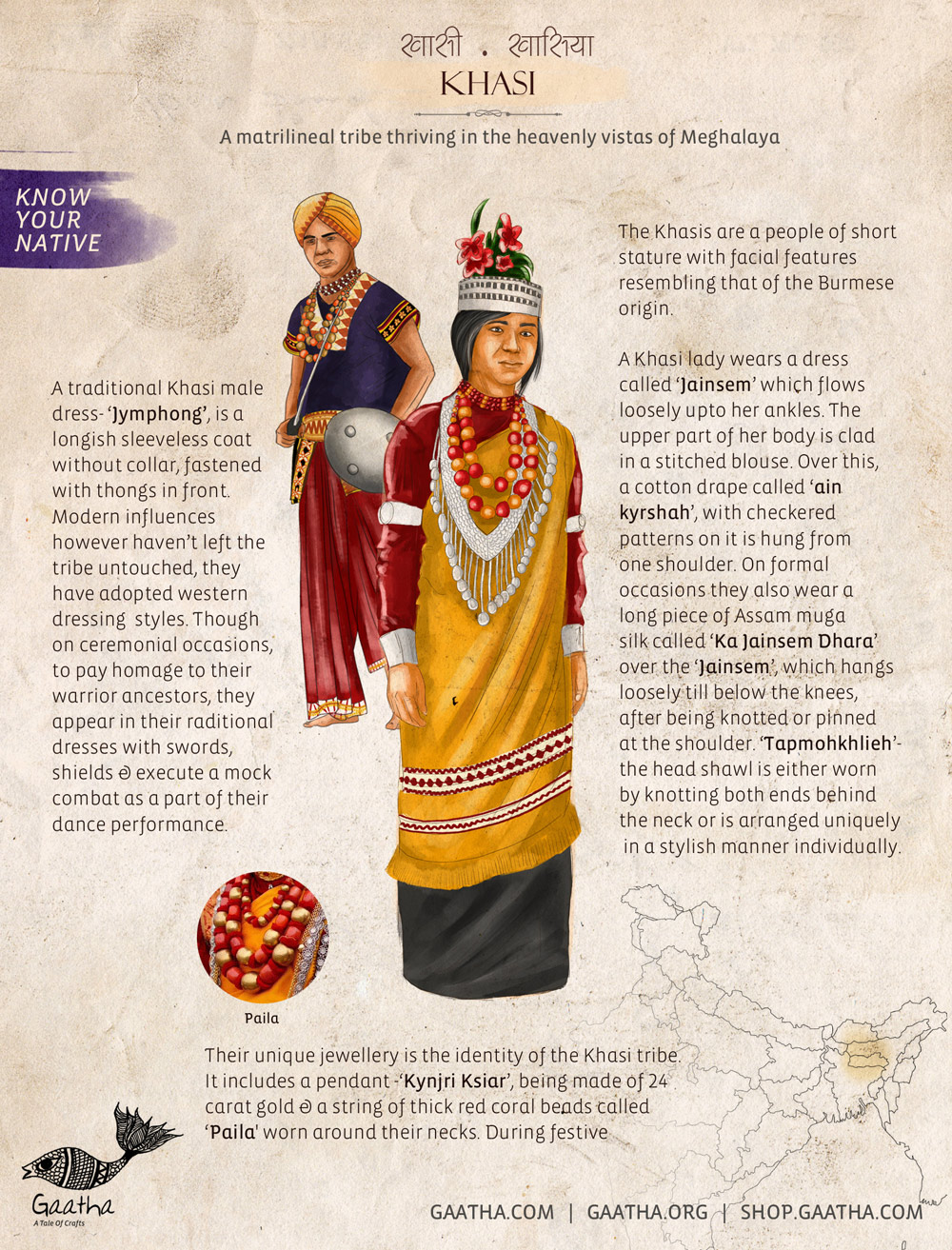
Khasi is one of India’s last few matrilineal #tribes where the family lineage is passed on through mother’s clan, and the youngest daughters-‘Khatduhs’ are the custodians of the ancestral property. Once married, men live in their mother-in-law’s homes. Children are given their mother’s name as surnames.
In Khasi dominated areas, Female elders called ‘mei’ walk through the aisles controlling the trade and ordering men who work for them to lift bags full of fresh produce.
According to local #folklore, Khasis come from seven divine clans. Historians trace them to an ancient Austric race in South-East Asia who descended from a Mon-Khmer group of people in the remote Burmese jungles. While it’s uncertain when Khasis migrated west to the mountains and foothills of north-eastern India, linguistic evidence shows that their language ; ‘Khasi’ has similarities to Mon-Khmer dialects.
According to oral history, they have patriarchal roots. As warriors, Khasi men often went down to the plains for clashes. During those battles, some men died & others settled for a new life in the plains. Left without their partners, Khasi women would remarry or find other partners, and it often became difficult to determine a child’s paternity. Society labeled the children as illegitimate and to avoid that slur on their women or children, the elders decided that the children should be given their mother’s last name. Over decades, this built up as a women supporting ecosystem, which now is coincidentally thriving!
The Khasis are famous for weaving cane mat, stools and baskets. They make a special kind of cane mat called ‘Tlieng’, which guarantees a good utility of around 20-30 years.
Their cultural heritage not only includes handicrafts but also performance arts! Few of the great Khasi ceremonial dances are ‘Lyiupiing’ – performed for worshiping ancestors and ‘Nongkrem’ – for worshiping nature. The drums, flutes, and brass with the gorgeous costumes of the dancing Khasis present a kaleidoscopic view of Colors in their outdoor day-time dances… the effect is even more surreal when the stage is set in natural scenery, in some grassy dell, surrounded by great hills, topped by blue skies!
THARU
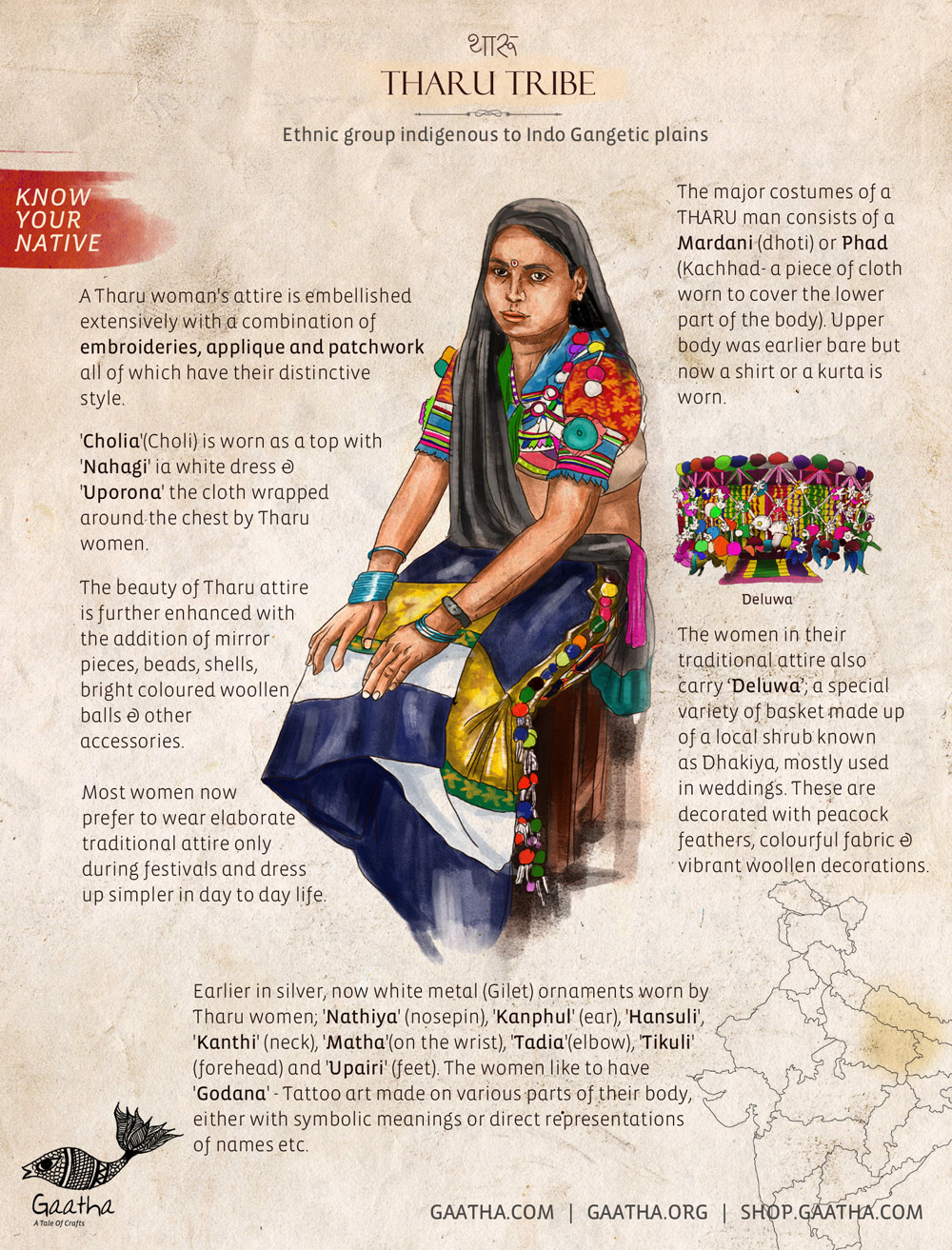
The word थारू Thāru is thought to be derived from ‘Sthavir’ meaning ‘follower of Theravada Buddhism’. Popular myth quotes that their lineage can be traced back to the Shakya clan; the royal caste into which Gautama Buddha was born. But a more accurate DNA study states their origins to be from Mongolia.
While the origin of the tribe is surrounded by myths passed down through oral tradition. A popular legend clarifies that Tharu, based on their physical characteristics belong to the Mongoloid race and claims for them to be of Rajput descent from their mother’s side. When Moguls conquered the Indian subcontinent in 16th century, one of them wanted to marry a Rajput woman. The women and children fled and settled in the forested lowlands, close to the Nepalese mountains. Their men stayed behind to fight the Mogul. When the women heard that all their men had been killed, they married their humble servants and slaves, who had accompanied them. Thus primitavly, they became a matriarchal tribe and men were traditionally served food outside of the house.
The mother tongue of Tharus has been divided into two categories – ‘Rana Tharu’ and ‘Dangaura Tharu‘. The tribe has over 50 different clans, with slight variations in vocabulary and tones of speaking their mother tongue.
In ancient times, the community used to live amidst marshy lands, in mosquitoes, reptiles and other insects. Over time, they developed resistance to these insects and their bodies developed methods for self protection.
The Tharu excel in the art of basketry and its related crafts. Women in the community weave these baskets themselves, which they say is an integral part of their wedding trousseau. They weave these baskets in varied shapes and sizes, according to the functionality they serve. ‘Panchhopni’ is used to cover up water pots, ‘Bhauka’ is used to store clothes, ‘Payin’ is used to cook ‘dhikari’ (a local Tharu dish) and a ‘Feruwa’ is used to store household items.
AO
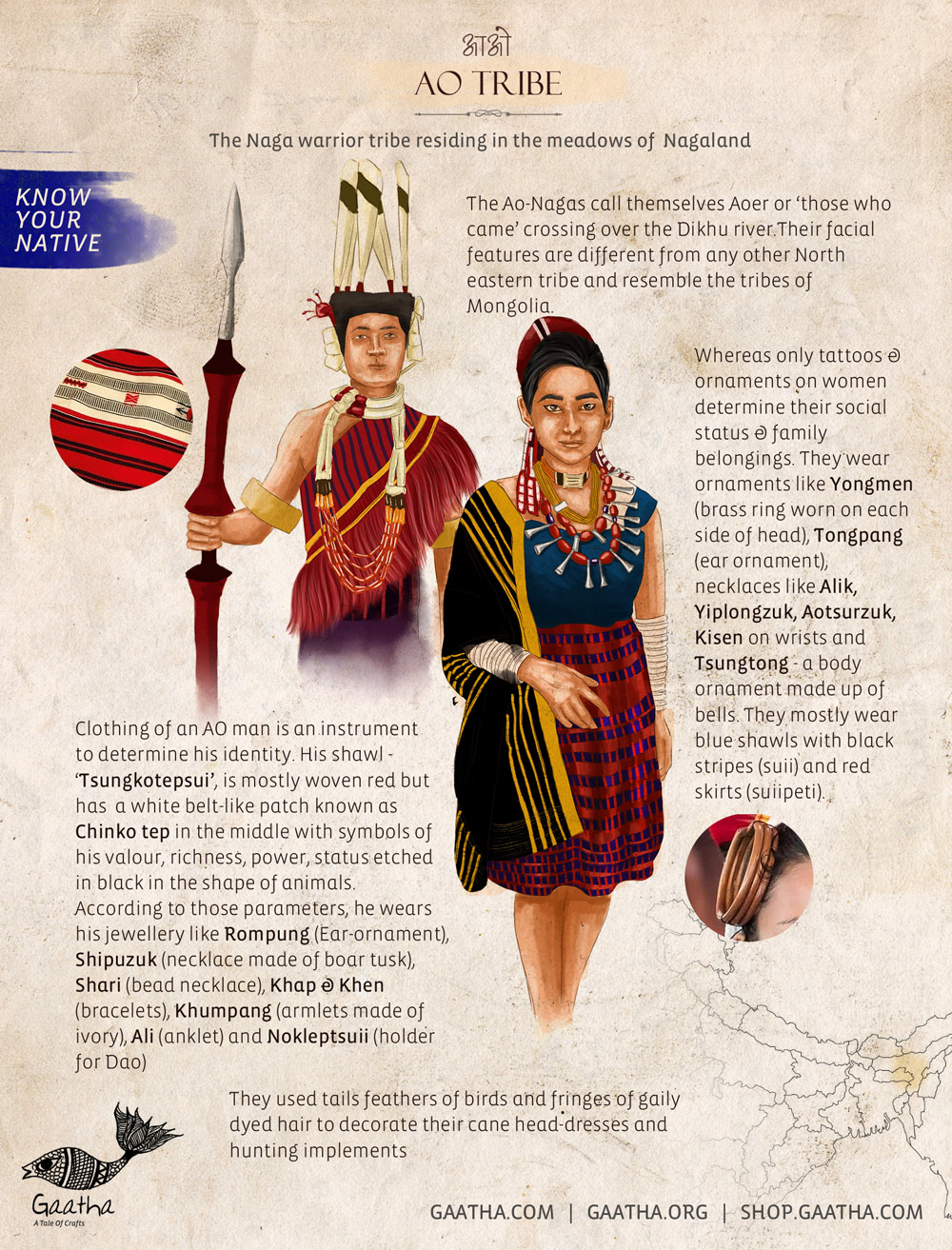
According to mythology they came out of stones and attained civilization.
They were originally a warrior tribe; always ready for battles with other tribes and hunting. Thus their indigenous weapons have become a part of their traditional attire.
AO was the first ethnic Naga to embrace Christianity post which they started writing their AO language in Roman script. They have majorly two dialects & sub clans- Chungli & Mongsen residing in their headquarters – Mokokchung.
Each element of the Naga textile has a tale to tell. According to folklore, the unique weave of the AO tribe was started by a lady called Longkongla to differentiate their tribe from the rest! Before weaving,the yarn is dyed using indigenous material sourced from the forests. Even the spindle is made of bamboo and startched with hot rice water. It is woven on a special loin loom made up of 6 bamboo sticks held parallel to each other or back strap looms.
Ao tribe shows signs of being animistic in nature. They may also be called polytheists, worshiping several benevolent and malevolent spirits and gods, at different times and occasions for different purposes. Their belief in the existence of gods forms the core of their religion and is a guiding principle of their conduct in life.
There were two important institutions in the Ao Naga society through which they learnt the social way of life: arju and tsüki. Arju was the bachelors’ dormitory, while the tsüki was for the young women folk. Both Ao men and women maintained separate dormitories.
Every Ao village was an independent state and each village was regarded as a republic. The ancient Ao village was a sovereign state, capable of internal administration and external diplomatic relations and welfare, with a pure form of democracy where every citizen enjoyed his freedom of speech and was respected.
GADDI
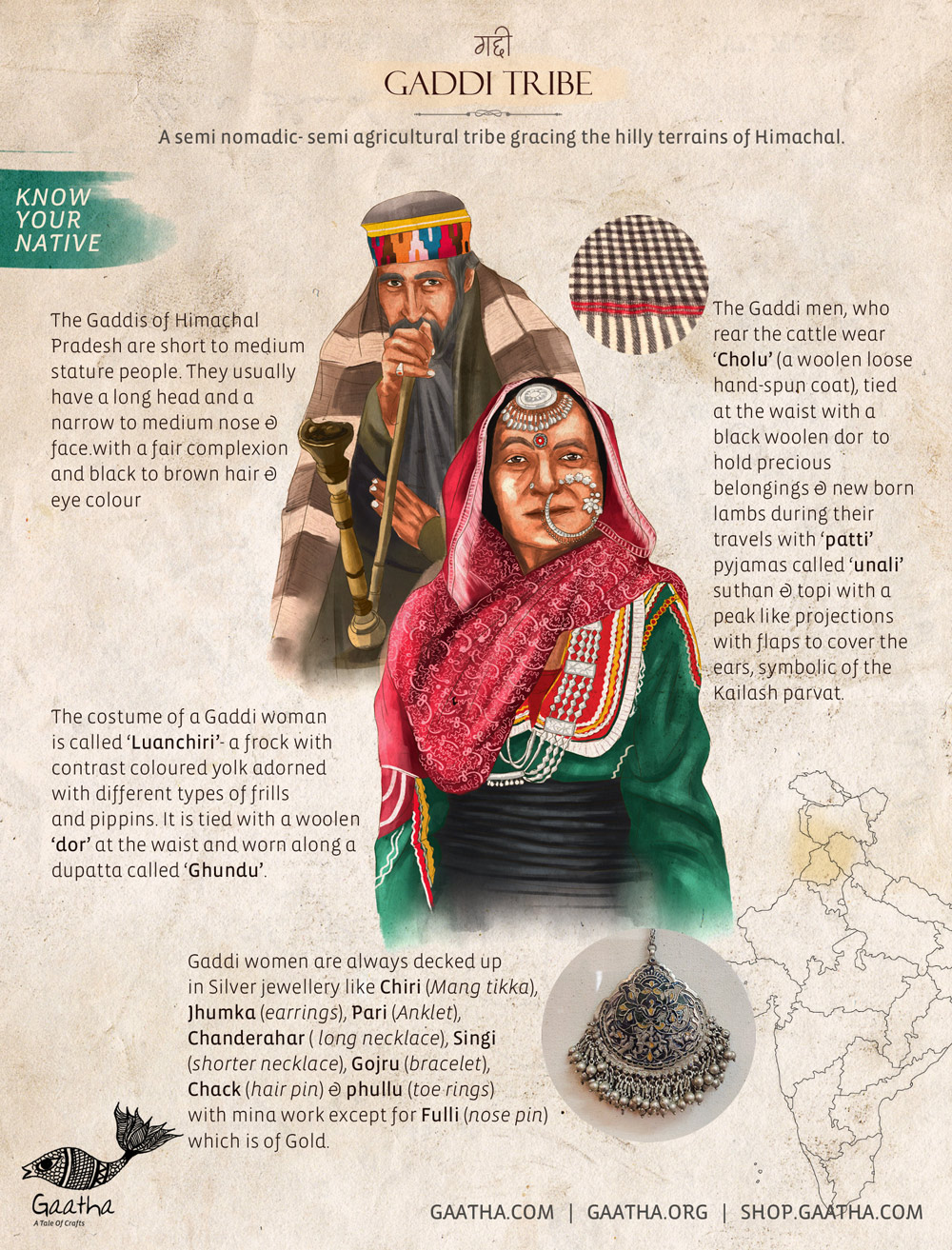
The word ‘Gaddi’ has been derived from ‘Gadar’ a Sanskrit word ‘gadhern’ where Gaddis are inhabited and a term in hindi use for shepherds. Some views are commonly held among these folks like Kailash is the throne (gadi) of the Lord Shiva. Therefore,those people who took refuge and settled in Brahmaur came to be referred as Gaddis. They also believe in supernatural powers of soil spirits, mountain spirits, forest spirits and tree worship, and water spirits. The Naag and Devi cults still have a powerful hold among Gaddis.
Their ancient language is ‘tankani’ which was verbal while the present language is ‘gadiali’- a member of pahari language family and is a mixture of Sanskrit, Punjabi, Hindi, Urdu, and English.
The community is famous for colorful woven handicrafts originally made to protect themselves from freezing conditions. Sheep and goat are considered as property of the Gaddi; ( The flock of 300- 400 heads is referred to as ‘dhan’ while that consisting of 800-1200 heads is called ‘kand’). Sheep wool is used for making various woolen articles; and skin is used for making kharchi and other useful products. The shawls made for males are of one colour and in black and white check, whereas shawls of females are woven in multi-coloured designs.
On the occasion of marriage the red coloured ‘Luancha’ and a colorful printed ‘Luanchadi’ are put on by the groom and the bride respectively, as per the belief that they symbolize Lord Shiva and Goddess Parvati, who are believed to have put on these at the time of their marriage
The shepherding Gaddi tribe have a huge bank of indigenous knowledge systems of ethnobotanical medicines which they often use during their travels like they wash the blankets with the black round fruit known as ‘Ritha’ in hindi and ‘goon’ or ‘rethe’ in gaddi language or crushed Batola leaves which is applied on external wounds to speed up the healing process.
The Gaddhis have coexisted with the ecology around them for generations but this valuable knowledge bank is getting erased as shepherding as a profession is dying.
MISHMI
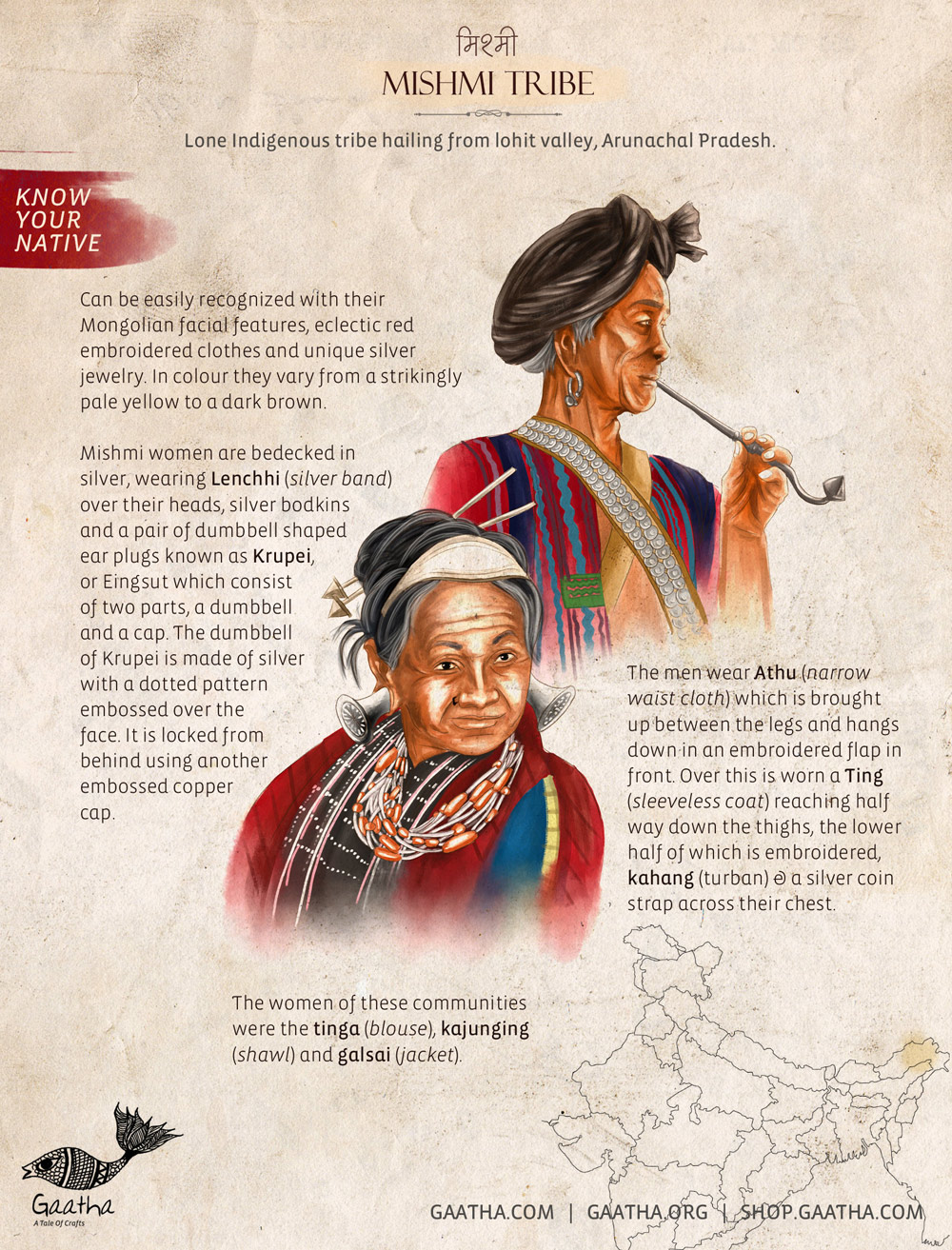
Mishmi Tribe | Arunachal Pradesh | Poster
The Mishmi are one of 26 indigenous groups inhabiting Arunachal Pradesh. The Indian Clans are called Idu, Miju & Digaru whereas the Chinese clan is called Deng.
Mishmi claims Tigers to be their brother and observes taboos against Tiger Hunting.
Mishmis (Miju & Digaru), who live in longhouses that stand on bamboo pillars, are one of the rare tribes for whom silver is more valuable than gold. Around the 16th Century, the Mishmis used to trade their yak leather, wool and tree fibre for silver and salt, among other things, at the Brahmaputra valley in Assam. Therefore, silver became a symbol of how well travelled one was and was highly prized for the status it gave its wearer.
The use of ornamental silver does not end at jewellery; a Mishmi is incomplete without his silver smoking pipe. This intricately ornamented three piece pipe consists of a cup and two or more additional tubes. The length of silver pipe represents the seniority level and social status of a Mishmi man.
Pigs are kept in large numbers and are eaten on important occasions, but fowls are used exclusively for sacrifice, and the Mishmi Hills must be about the only place in India where travellers cannot buy a chicken.
SIDDHI
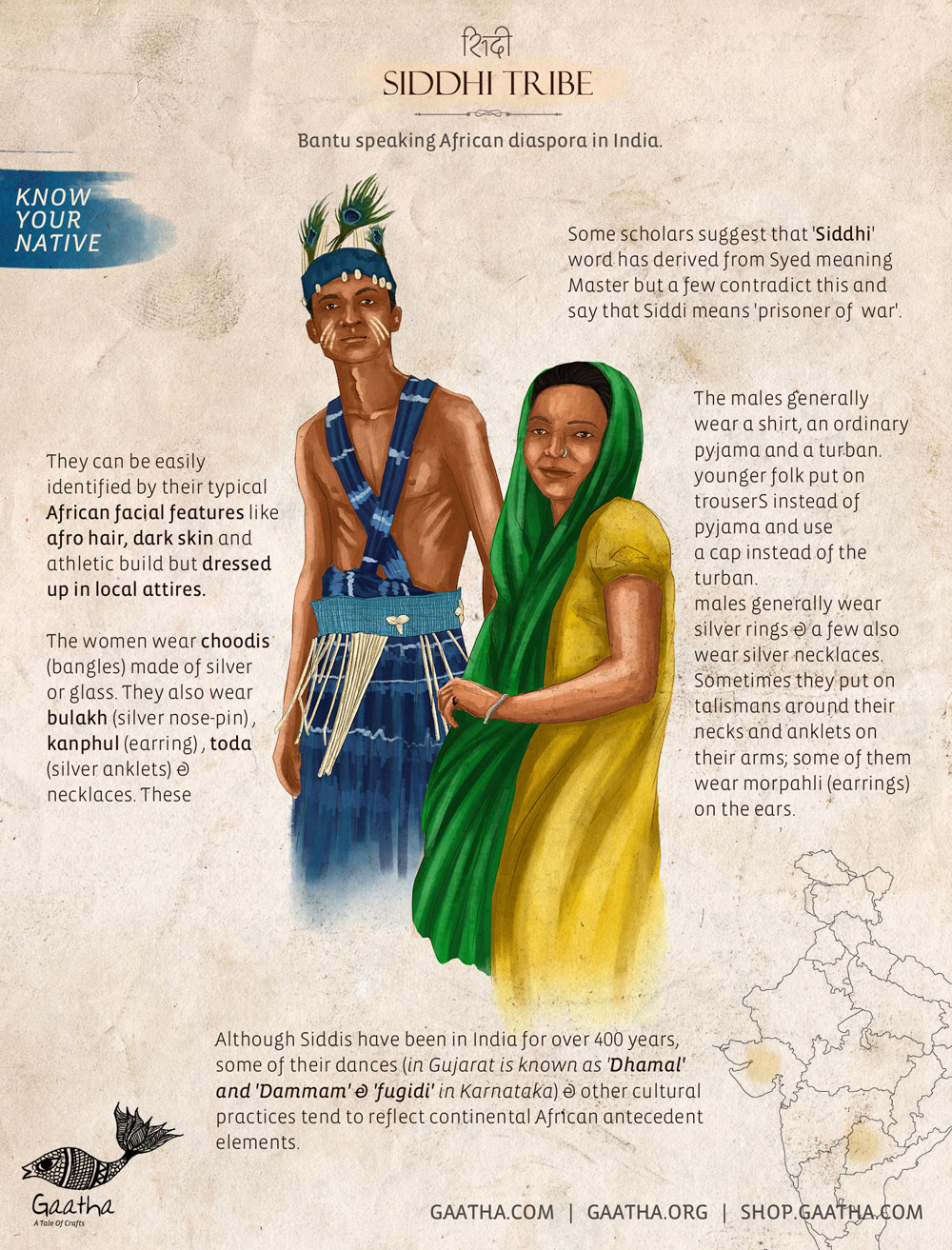
Indian Africans or Africans in India?
From the early seventh century to the beginning of the twentieth century, Africans, called by Arab slave traders and Europeans variously as “Abyssinians”, “Ethiopians”, “Habshis”,“Coffrees” and “Siddis”, had been arriving in South Asia as part of the early Muslim Omani, Arab, Indian, and later Portuguese trading activities.
Indian African community, popularly known as the Siddis, commonly reside in parts of Gujarat, Maharashtra, Andhra Pradesh & Karnataka. Today they do not know anything about where they came from. The African diaspora in India, along with their local Indian language, speak Swahili language; the words of which have even evolved out of its African counterpart. They speak Gujarati, though their voice is glotto-pharyngeal in sound. N is pronounced as L. Local Gujarati claim to find African words in their vocabulary, but no linguist has so far confirmed this.
Among the Siddis, followers of three religions,· namely, Islam, Hinduism and Christianity are found. Most of them, however, are adherents to Islam. The Siddis marry within their community. However, the Hindu, Muslim and Christian Siddis, form a s~parate endogamous group each.
On the occasion of the urs as well as other religious occasions, the Siddis perform a very interesting dance, known as dhamal, which is characteristic of their own community. This is a very engrossing performance, which is also puformed on the Thursday of every week and on the 1st and II th days of every Muslim month.
The instruments used during dhamal are peculiar to the Siddis and are believed to have been given to them by their Abyssinian saint, Baba Ghor.They hold their musical instruments in great veiIeration, never touching them unless ceremonially required.
It happened only in India, that the Slaves rose to power. Because of their physical strength, they reached higher positions of Military Generals and subsequently became trusted, loyal advisers to the Kings. They also became rulers with the Habshi dynasty of Bengal (1486-1493).
BHOTIA
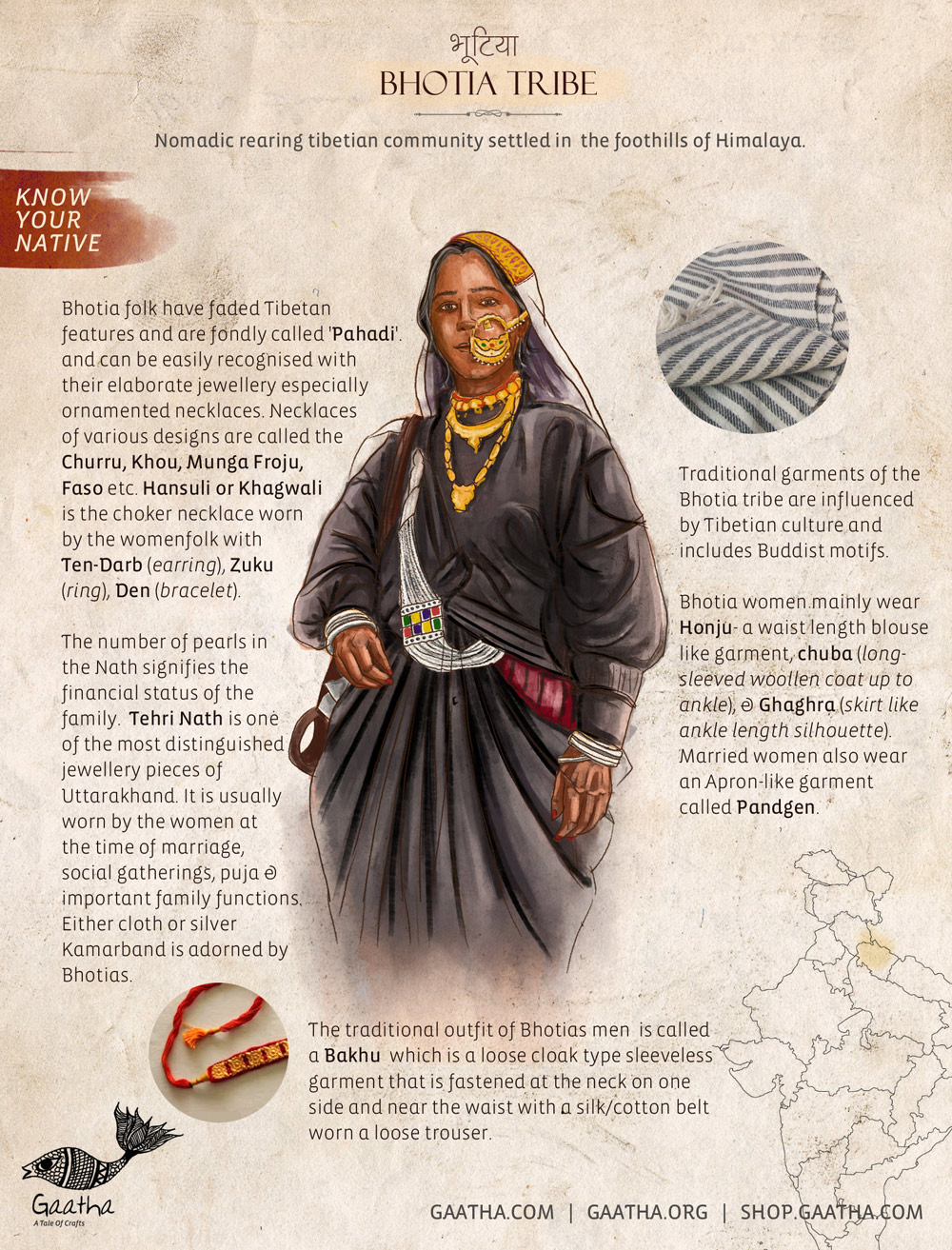
Bod, the native name of Tibet, corrupted by the people of India into Bhot – has given rise to the name Bhotia for the people of the border tribes between the two countries. In Uttarakhand, the Bhotia primarily reside in the districts of Pithoragarh, Chamoli, Almorah, UĴarkashi and Nainital.
Since the Bhotia have lived in such surroundings for a long time, they have amassed a fine knowledge and use of wild Himalayan medicinal plants, herbs, tubers, roots, barks, flowers, and seeds for curative purposes, and this know-how has led to their fame all across India.
Due to the ancient times of their trade with Tibet and cold climate in the high hills where Bhotias inhabit, their cloths mainly comprise woolen material, quite often home made. For centuries their women have been moving their small “pithachan” (loom). Ptdu, thulma, carpets, chutka, lava, blanket, shawl, asan, pankhi, gudma etc. are prepared very artistically. There was a very close bond between the Bhotia and Tibetans across the mountains for centuries
the Bhotia have a rich oral tradition of folk songs, dances and tales that they often share with other communities. Chhura is a popular dance which portrays an experienced older man teaching a young shepherd the secrets of his trade. Both men and women participate in this dance. Social control is handled by elders and respected members of the community.
According to the locals and legends, it is said that the people who have passed away in the Bhotiya region, their souls get trapped within the body of the goats and sheep present in the town. Performing this dance helps in liberating the souls of the Bhotiya tribe.
TODA
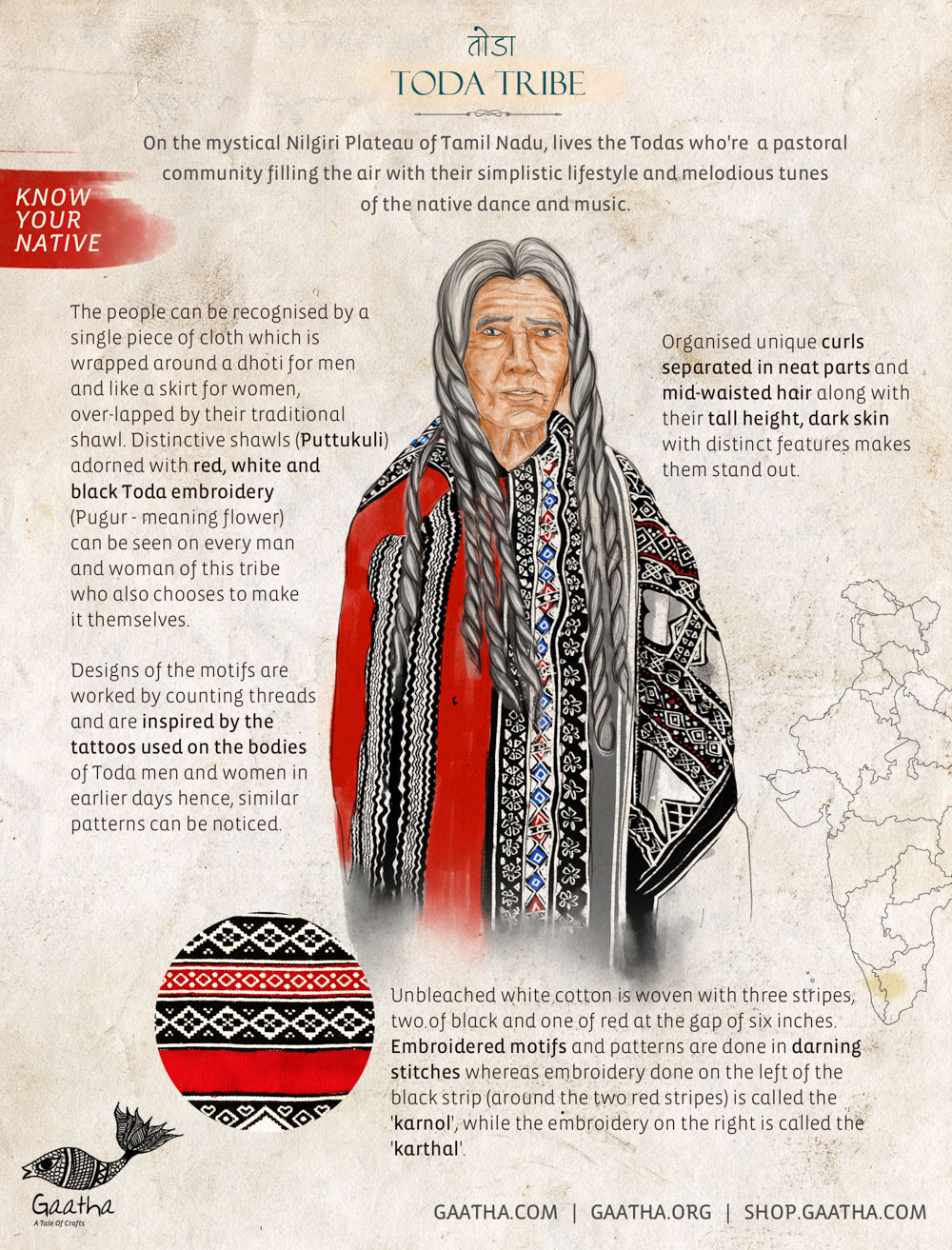
The mystical Nilgiri plateaus of Tamil Nadu, are occupied by the simple yet sophisticated, pastoral community of Todas, also known as Tudas or Tudavans, who have been living here since centuries. They have always found themselves to be closely associated with nature. Todas got their name from the word ‘tud’ which is the sacred Tud tree. Their houses called ‘Mundh‘, are constructed using natural resources and are interestingly decorated using Toda art form- rock mural painting.
Regular farming and nature adds a consistent amount of monotony in a Toda’s life who’re purely vegetarian. Tribal people are endowed with enriched traditional wisdom to use available resources around them. They are well versed in the usage of plants for treating various diseases.
Buffaloes are considered the supreme power and are worshipped in Toda temples. The prosperity of each house is judged by the number of buffaloes owned by it. The magnificent water buffaloes bred by Todas can be fierce and also life-threatening. Buffalo horn design is a significant factor, since they’re worshipped by them. Their fascinating range of customs and beliefs, during festivals and funerals, songs about the cult of the buffaloes are composed and chanted. Poetry and music are an essential part of the Toda culture and men and women often compose songs about important events, using a special poetic language.
RABARI

The Rabari community is divided into sub-groups, There are a total of 133 ataks in the community, which are recognised collectively as vihotter. Kachhis, Vagadias & Dhebarias are the three broad sub-groups of the Rabari community who reside in Kutch.
According to different sub groups and age, rabari women decorate their dress & objects by unique ranari embroidery, Interlacing stitch (bavaliyo), chain stitch, Dana (basting), patch work, Bound mirror(bandha kach). Special motifs of their community identity like Peacock, Sudo(parrot), Ambo(mango), Panihari (women bringing water), Sandiyo(camel), Vicchi(scorpion), Bajubandh (arm bend). Zarmar(necklace) ,Makodiy(zigzag) etc are embroidered gracefully.
Black color dominates their clothing colour palette as according to their legends, the community is mourning the loss of members who sacrificed their lives fighting against a King who fell in love with a Rabari girl. To escape the wretched king, the community, along with their cattle fled to Kutch from Rajasthan.
According to the legend, the Rabari community was created by Lord Shiva along with a 5 legged Camel designed by Goddess Parvati. When Sambad, the first Rabari, complained about the difficulties faced by the camel while gazing, Lord Shiva pushed the central leg upward and thus, formed the hump!
Sambad was married to an Apsara named Rai and their progeny was called ‘Raika. The lineage of Sambad and Rai continued their father’s occupation of animal keeping and prospered. The community is known by different names in different states, like Rabari in Gujarat, Raika in Rajasthan, Pal in Punjab, among others.
Given their bond with the Mother Goddess, Rabari social structure is matriarchal, with women conducting the majority of their business affairs & managing their villages, while men are in charge of the animal herds that form the only true Rabari assets.
MURIA
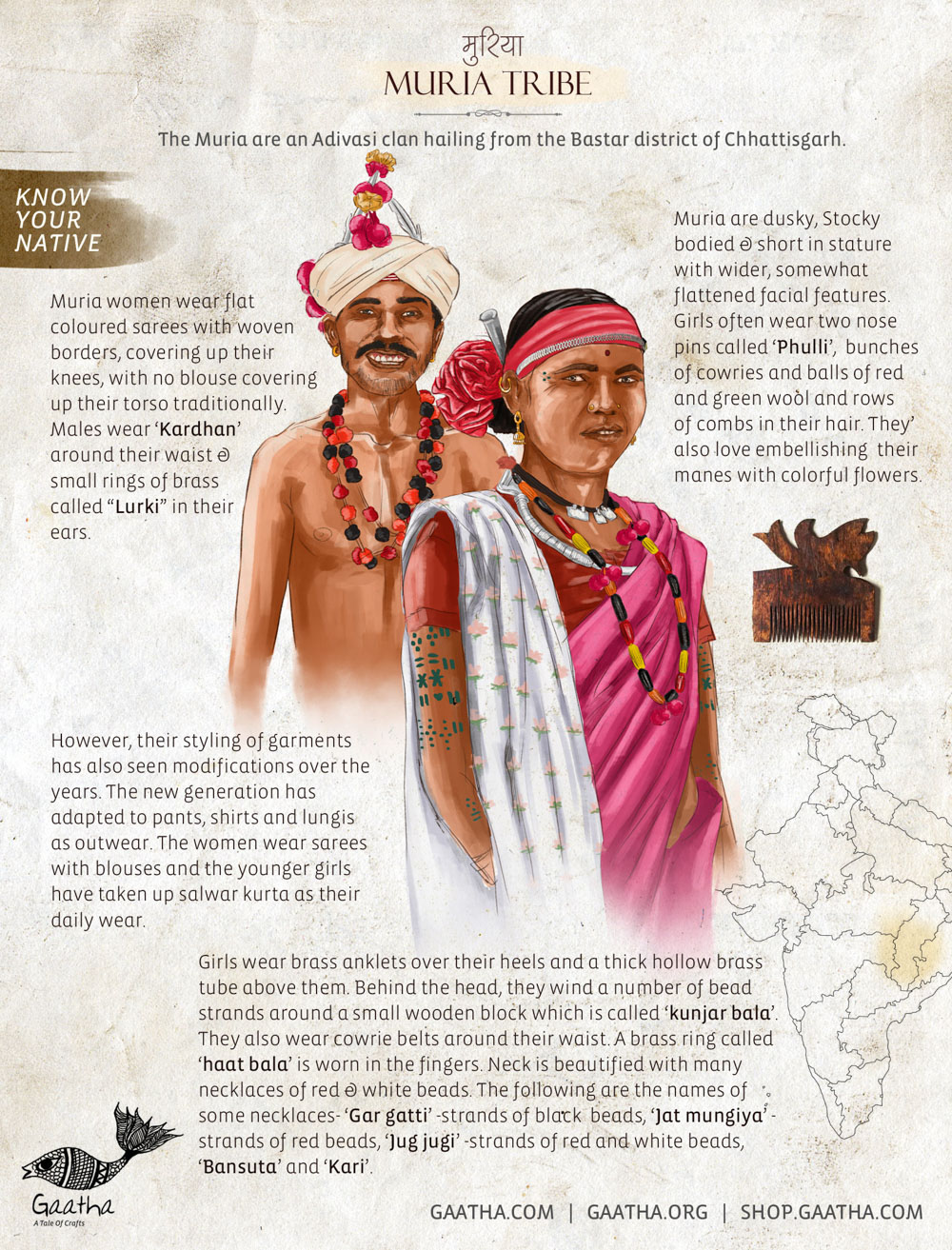
The Marias and the Murias are sub-groups of the Gond tribe of Central India.
The Murias traditionally follow animism. As far as religious and social beliefs are concerned, they have several totems and several gods of the village and tribal sub-groups and believe in sorcery.
A distinct feature that separates the Muria from other tribes is the ‘Ghotul’, a dormitory established to create an environment for the new generation to explore their sexuality. These ‘Ghotuls’ also act as education centres for those aged 10 and above. The initiation ritual takes place at nighttime, where drums are played, songs are sung, food is served and youth dance, play and tease each other. The ritual starts by introducing themselves to their partners, the girl selects a boy and takes out a wooden comb from a pot, which has the name of the boy she wants. The comb is placed on her hair with her permission and couples are formed. Then they are allowed to check their compatibility with the partner, to their satisfaction. The open practice comes with some rules to follow, where the girl must be at-least 18 years old and the boy must be 21 years old at the time of the ritual.
The beauty of this tradition is that the consent of the girl is very important and she’s allowed to say ‘NO’ even after the ritual is consummated. The Motiari (Muria girl) can reject a Chelik (Muria boy) even if she had accepted the flower and said yes in the first place if she wants.
LAMBANI
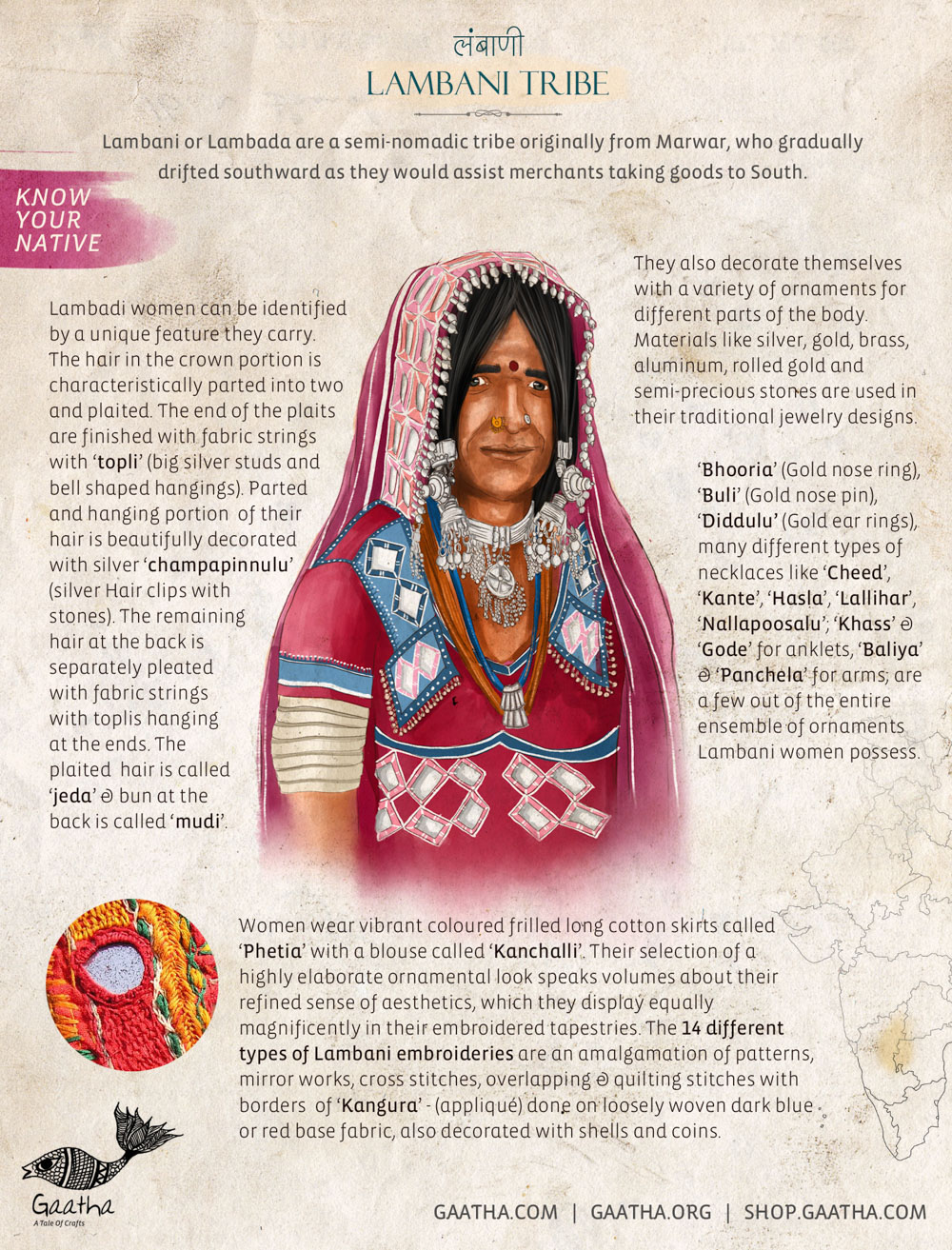
Lambani or Lambada are a semi-nomadic tribe originally from Marwar, who gradually drifted southward as they would assist merchants taking goods to South. After their migration from Marwar, a part of the tribe resided permanently in the south western part of India, mainly in the state of Karnataka.
Lumbani is a banjara community now mainly found in Karnataka and Andhra Pradesh regions of India. Sanskrit words ‘Banij’, ‘Baniya’ and ‘Banajiga’, all refered to the ‘merchant’ class. They are also called by other names, such as ‘Lamani’, which in Sanskrit means ‘Lavana’ or salt. Labhans are the salt carriers, hence they were known as Lambada, Lambadi, Lambani or Banjara. During Mughal times Banjaras assisted merchants to export goods to South. That was the first time they moved to south. In the 18th century the British authorities framed the community under the Criminal Tribe Act of 1871 and stopped their movements. This continued until 1952 until the act was finally eradicated in Independent India. Later some of the families decided to settle down in Karnataka and Andhra Pradesh permanently. They don’t own farms but work in other’s farms and earn wages. The place they live in is called ‘Tanda’, which is usually located outside of a village. Their houses usually consist of a small room with no opening except the door.
The females of Lambadi tribe are evidently fond of ornaments and have a variety to beautify nearly every body part but they also carry their wealth with them in the form of these ornaments. However, it has been a trend now for the tribe to sell off their silver ornaments to make the ends meet.
KUNBI
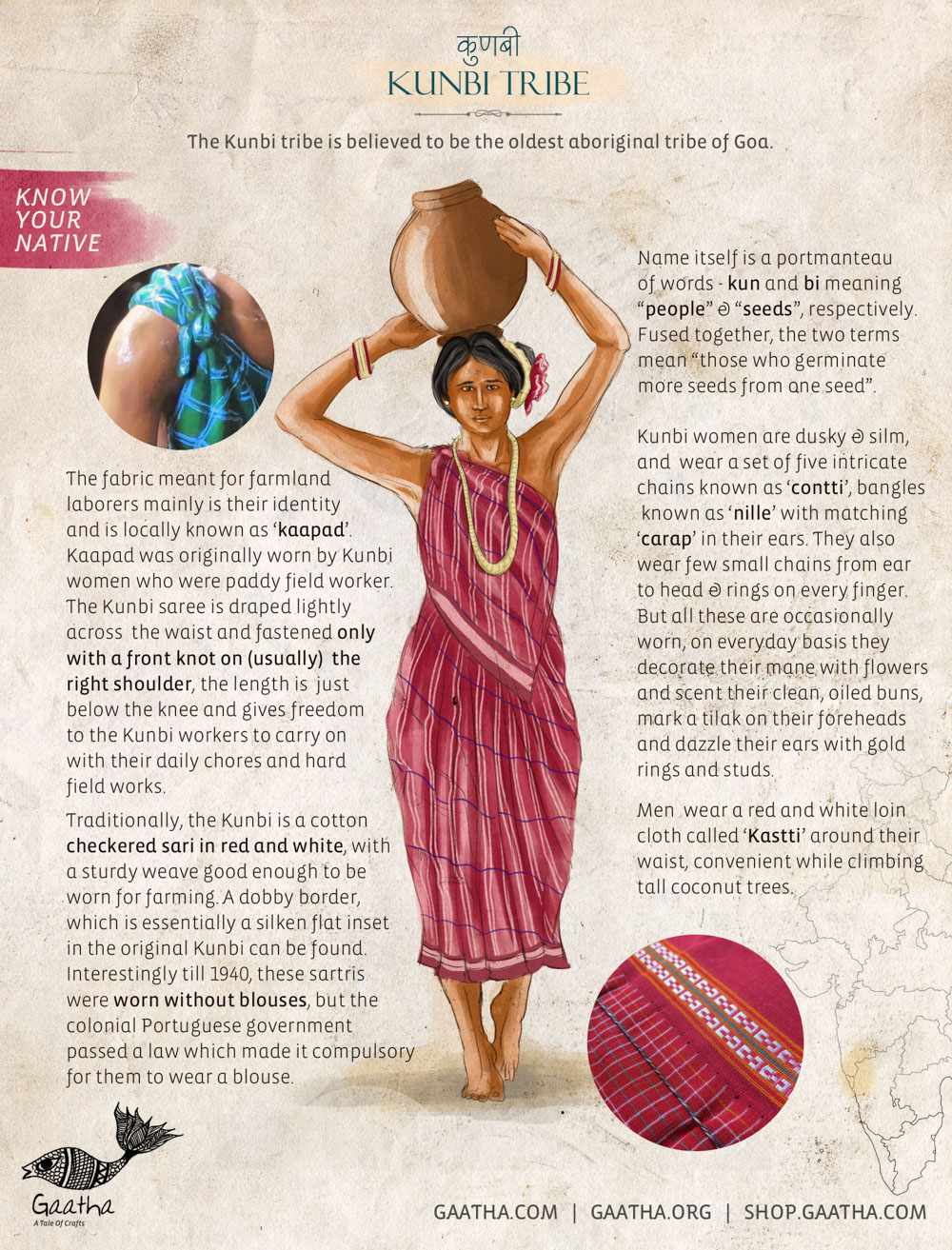
The Kunbis are said to be the aboriginals of Goa and surrounding Konkan areas. Their folk songs emphasize that they are the original cultivators of Goa and that all the land in Goa had at one time belonged to them. Another etymology states that the name Kunbi has come from the Marathi word ‘kunbawa’, or Sanskrit ‘Kur’, meaning “agricultural tillage”. Thus, anyone who took up the occupation of a cultivator could be brought under the generic term Kunbi. They are largely agriculturalists, though some of the oldest known landowners in Goa were of this class, and claimed for themselves the vaishya (merchant) varna.
According to Goan historian Anant Ramakrishna Dhume, Kunbis are modern descendants of ancient Mundari tribe. In his work, he elaborates on the deities worshipped by the ancient tribe, their customs, methods of farming, etc They are a sturdy tribal community mostly settled in Salcete region, who were Hindus, some of them were converted to Christianity during the Portuguese era, have still retained the most ancient folk tradition of the land.
Known to be terribly straightforward and tireless folks, they lead a straightforward life. Nurturing lush fields and dwelling in houses of mud walls and bamboo roofs adorned with coco leaves or straws. They live clustered into many hamlets called ‘kutumba’, from the Sanskrit word ‘kutumbakam’ which implies a family. Kunbis have a fashionable tradition of art and culture to which they attach a lot of importance. Shigmotsav, a spring celebration in February-March hosts grand ceremonies for social groups. Applauded as an extremely choreographed affair, this pageant brims with many folk themes that flow through the streets.
In a history spanning over 2000 years, Goa has been shaped by the Bhojas, Shilaharas, Rashtrakutas, Kadambas, vijaynagar rulers, Adilshashi and finally the Portuguese. The changing colours of history have left their multiple and lovely shades on Goan life. And folk art has not been an exception to it. The traditional folk music and dances have continued uninterruptedly, while Portuguese influence has left newer versions.
KINNAURA
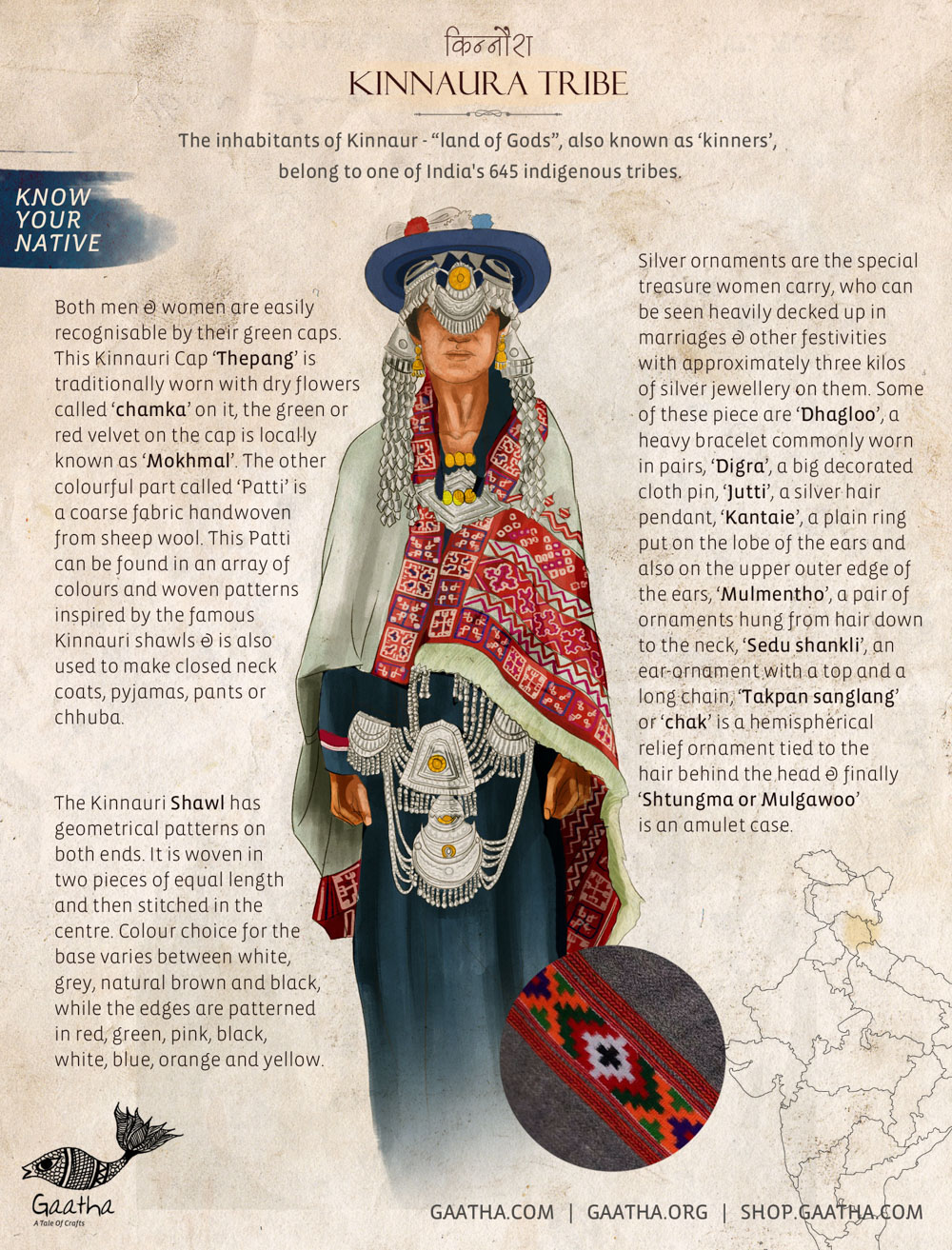
Because of its remote geographical location along the borders of Tibet and China, Kinnaur remained inaccessible till very late, the exchanges were rare and their culture flourished in its own unique way. According to Bhagwat Purana, Kinners trace their origins to Lord Brahma. People of the tribe are said to be ‘Ashwamukha’, with a look of half-man and half-horse. According to a legend, Pradumana, son of Lord Krishna was the first king of Kinners. Kalidas has aslo mentioned Kinners in his book Kumarasambhava.
The learned writer Rahul Sanskritayan in his famous book ‘Kinner Desh’ has written about the life of Kinnaur along Tibetan borders towards the south-west of Kailash Mansarovar. Many other ancient texts describe them as dwellers of the Himalayas like Himvaan and Mahaneel. Over time, the tribe confined itself to the inner Himalayan regions between the Sutlej and its tributaries.
The Jataka stories make a mention of the Kinneris in the Himalayas, with vivid descriptions of the beauty and melody of Kinneris, who are depicted as lovers of ornaments and skilled in decorating themselves with leaves and flowers.
Temples in Kinnaur have architectural similarities to monasteries. The royal palace of Kinnaur too has a very Tibetian feel to it.
Religious festivals and wedding ceremonies are the best occasions to witness the culture; during these events, women adorn themselves with spectacular silver jewels, covering their entire bodies and men perform trance dances lifting palanquins.
KALBELIA

If it’s true that we are the sum total of five most closest people around us, then the Kalbelias must be embodying serpent, for snakes is what they surrounded themselves with since time immemorial. And then those hypnotising eyes, the meandering lean figures of their flaring bodies clad in silver & black, as they move to the tune of ‘Been’ against the sublime Thar scapes…are nothing but mirages amid vast deserts. Scorching sands, stale winds, temporary homes and uncanny traditions; the Kalbelia are not unfamiliar to these facets of tough nomadic life. Commonly recalled as migrating gypsies, they are known for their frequent shifting of dwelling from one place to another; catching snakes and trading snake venom. Therefore, the popular Kalbelia dance movements and the traditional costumes of their tribe bear a stark resemblance to that of the serpents. They are also known as ‘Sapera’, ‘Jogira’, or ‘Jogi’ for the same reason. The Kalbelias trace their ancestry to the Nath tradition. The identity of the gypsy folk is deeply rooted in their religion and their beliefs; they are followers of Guru Kanipa, one of the nine masters who reside on Mount Kailash, alongside Lord Shiva.
Though traditionally snake charmers, the tribe entirely shifted to folk dancing & music after the introduction of the Indian Wildlife Act in 1972 made snake charming illegal. The Kalbelia dance is only performed by women while men play the instruments and provide background music. The ladies of Kalbelia clan curve, influence & turn to the music played by their male partners. The moves made by them being serpentine. During the dance the Kalbelia dancers (mainly females) wear long black skirts embroidered with silver ribbons. As they spin in a circle, their bodies sway acrobatically, sinuously to the accompaniment of the ‘Pungi’, the ‘Dufli’ & the the ‘Dufli’ and the plaintive notes of the ‘Been’, the wooden instrument of the snake charmers. Tattoos, adornments and dresses woven with little mirrors and silver strings are other vital parts for grand serpentine show to unfold.
JAWARA
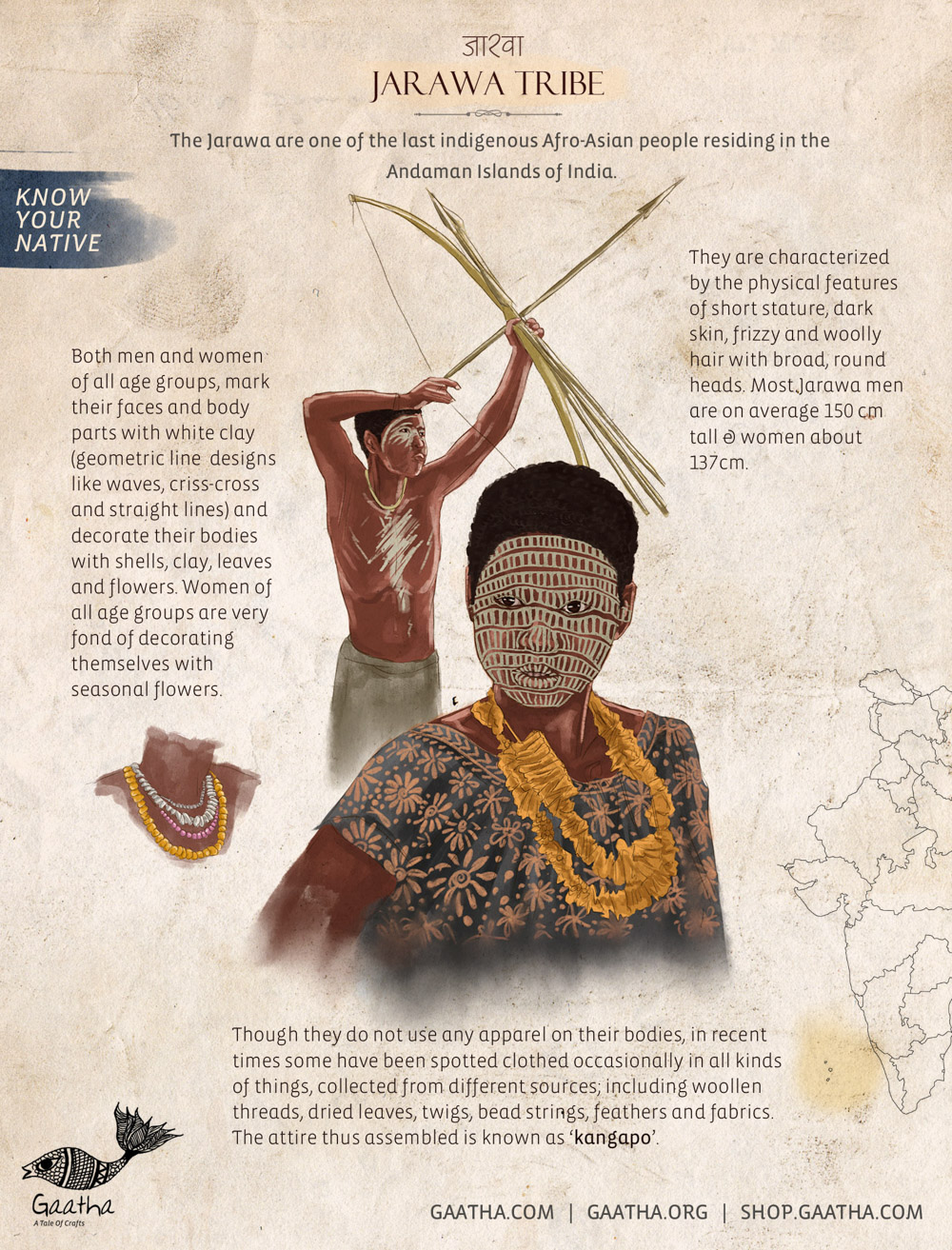
They are known to be the last descendants of the first modern humans, who left Africa to explore the world 70,000 years ago. There are no more than 400 of them left now, who live discretely in groups of 50 individuals. They are the pygmies living on an island, leading a hunter-gatherer lifestyle in complete isolation from the world and they have lived like this for tens of thousands of years.
Semi-nomadic in nature, they make bows and arrows with which the men hunt wild pigs, monitor lizards and fish dwelling in coastal waters. They also fashion canoes, simple stone tools and various types of baskets, which are both beautiful and highly utilitarian.
Their diet consists mainly of pretty much everything edible to be found in the vicinity; wild pigs, turtles, crabs and fish that they catch in coral reefs. They also collect fruits, roots, tubers and honey. With no knowledge of modern medicine, the Jarawa rely heavily on their natural surroundings and their age old knowledge of plants to treat illnesses. To battle cough and fever, they tie the leaves and stems of the Amomum Aculeatum Roxb to their chests. The leaves of Myristica Andamanica are used to coagulated bleeding, while the betel leaf – Piper betle, effectively kills pain. They are known to possess a detailed knowledge of more than 150 plant and 350 animal species.
DONGRIA KONDH
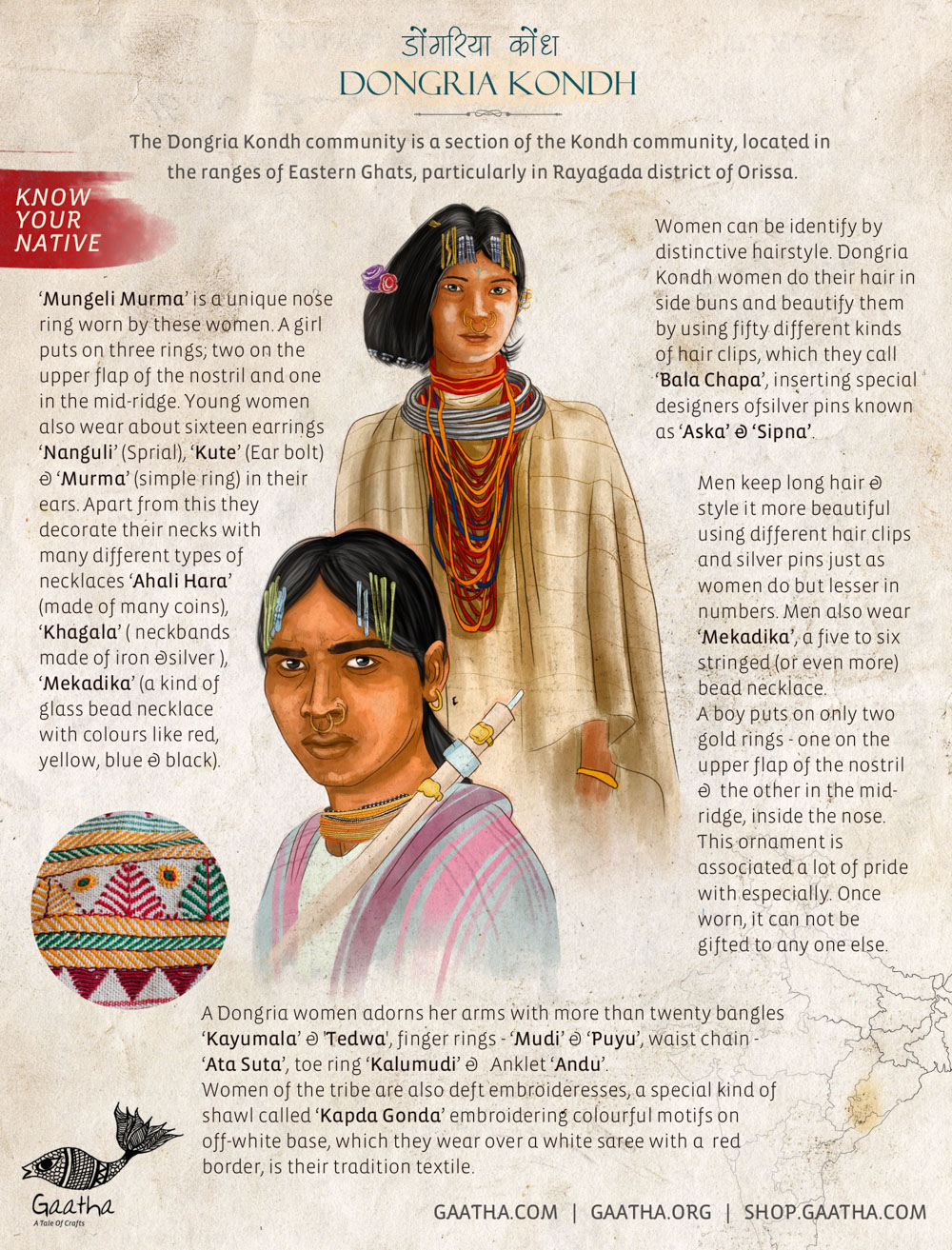
The Kondhs are a tribal community with several sub-groups like Dongria, Desia etc., The name Kondh is said to be derived from the Telugu word – ‘Ko’ or ‘Ku’, meaning mountains, therefore a Kondh is a ‘mountain dweller’.
The Dongria Kondhs alone are settled in more than 300 settlements or hamlets across the Niyamgiri hills and they live by the laws prescribed by Niyamraja, their Supreme deity. These settlements are always located within their clan territories. A settlement is almost always built on a gentle hill slope, traditionally constructed in parallel rows. The fields and the forests of the Niyamgiri hills are the educational institutions where the Kondh youth and children find themselves gaining skill and knowledge needed for lifetime. The people exhibit their distinctiveness though clothing, ornamentation and hairdos. From the very look of a person of the tribe, one knows that they belong to the Dongaria tribe. When babies are born, parents adorn them with nose rings, earrings, bangles and waist chains after just one month of their birth. And they continue to add more jewellery with age. Both men and women fix beautiful combs on their hair.
The tribe has adopted a system of imparting cultural and traditional values to the adolescents and youths in their villages through exclusive youth dormitories. Young unmarried boys and girls from the village leave their parents’ homes and stay in village dormitories, where they are taught by the elder youth; the philosophical and practical aspects of life within the community and the natural environment. They are taught about culture, territory, marriage, economics and society. Apart from which they also find loves and suitable matches for themselves while interacting and living together. The bachelors – ‘Dhangadas’ or ‘Dhangidies’ adorn ornaments to attract each other. Dongria Kondh boys and girls exchange gifts of ornaments as symbols of love
The distinctly peculiar characteristics of indigenous tribes of India have always been found fascinating, whether one has come across them virtually or physically. They not only add to the diversity of our country but also bring back the historical significance of tribes which remain untouched by the wave of westernization. In order to preserve and celebrate our native Indians.
BROKPA
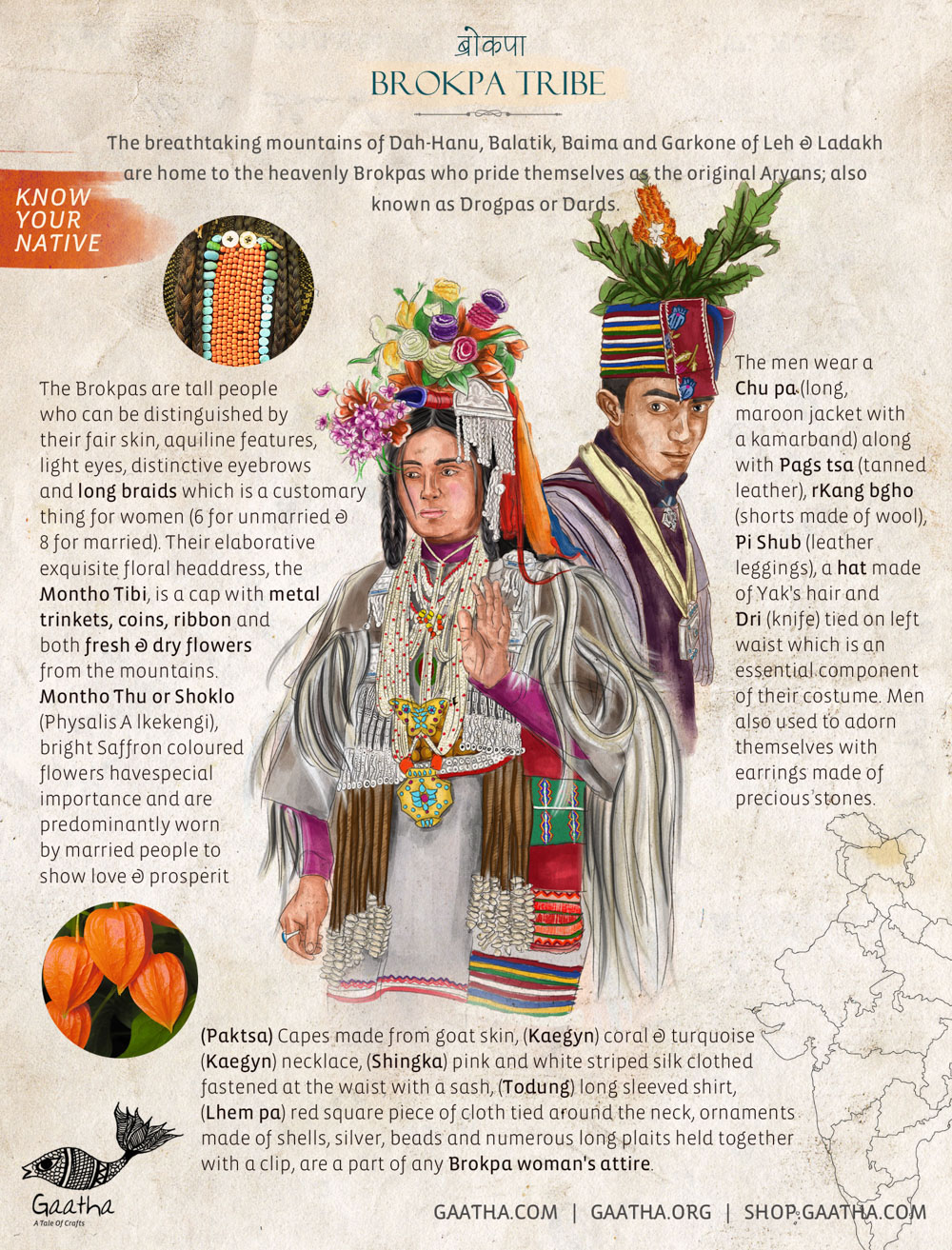
The breathtaking mountains of Dah-Hanu, Balatik, Baima and Garkone of Leh and Ladakh are home to the heavenly Brokpas who pride themselves as the original Aryans; also known as Drogpas or Dards. ‘Brog’ means hills and ‘pa’ means ‘inhabitants’. These mountain-children vigorously believe themselves to be the pure bloodline of the Aryans and often call themselves Minaro (meaning Aryan). Brokpas’s purity of race and culture has been maintained without being hostile to the influence from the outside world. Their way of life and genetic uniqueness has been preserved because of their strong social rules and pride in their ancestory.
Each object of adornment in the Brokpa community is believed to have a special healing purpose. Each prop on the head gear has some medicinal purpose. The seven colored ribbon wards any ailment caused by the Sun or eclipse. The silver brooches ward off planetary influences, the peacock feather wards off paralysis”. Healing of all illnesses rests on religious beliefs. Juniper (chillgi) plant holds a significant place for Brokpas and is used for spiritual healing as well as, as an anti-pollutant in their religious ceremonies.
Mountains, trees, water and flowers are considered very pure and thus every Brokpa household grows flowers. Singing and dancing are also an essential part of the culture and various beautiful adornments on people can be noticed during festivals. Brokpas are pure vegans, but goat meat is consumed during festivals. Products of cow like milk, meat or even cow dung even though it is essential considering the scarcity of fuel, is still strictly avoided. Their other major characteristic is that they are a high altitude pastoral tribe, who graze land at 3000m to 4500m altitude with yak, cow and sometimes sheep.
BONDA
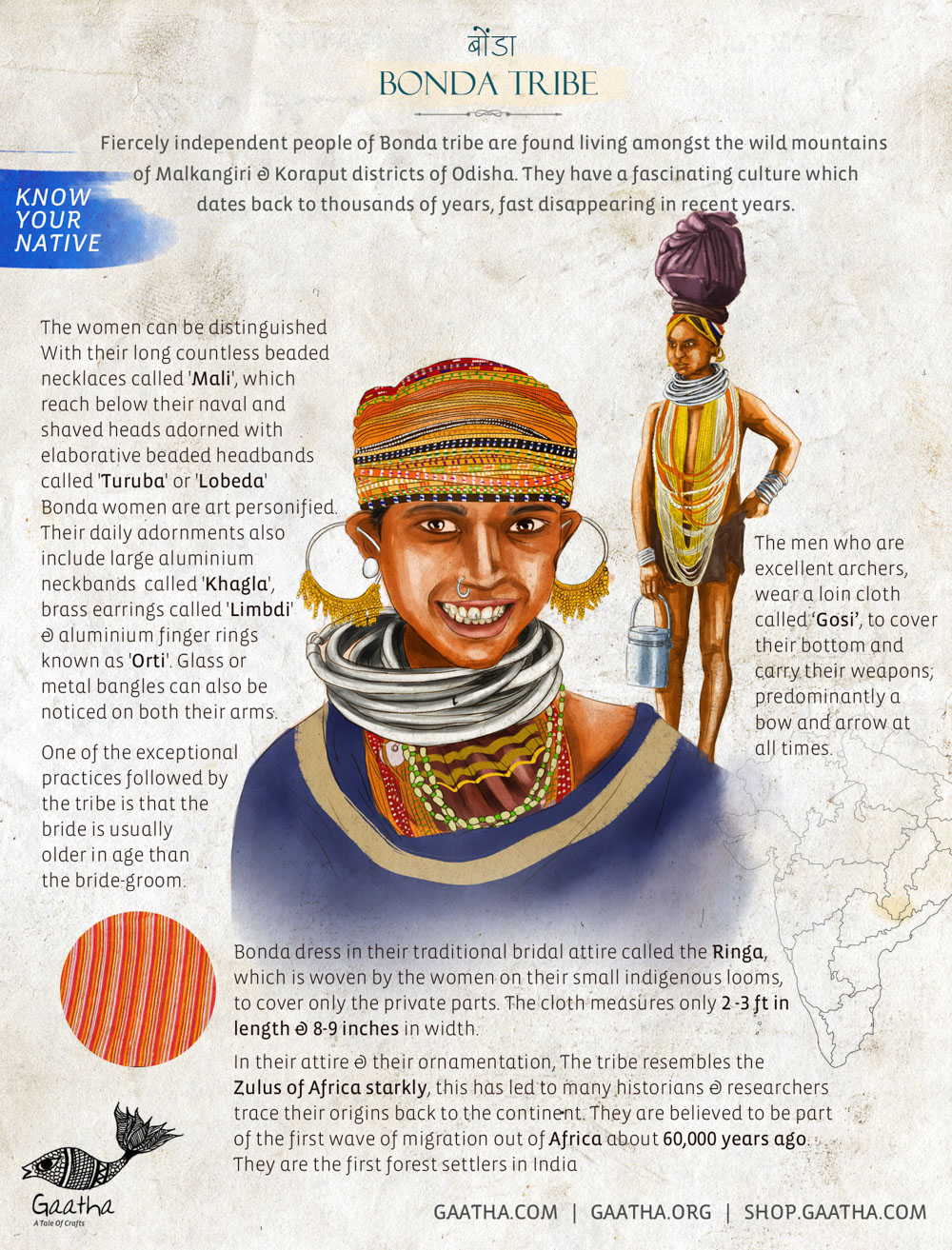
Fiercely independent people of Bonda tribe are found living amongst the wild mountains of Malkangiri & Koraput districts of Odisha. They have a fascinating culture which dates back to thousands of years.
One of the exceptional practices followed by the tribe is that the bride is usually older in age than the bride-groom. Bonda brides dress in their traditional bridal attire called the Ringa, which is woven by the women on their small indigenous looms, to cover only the private parts. The cloth measures only 2 -3ft in length and 8-9 inches in width. In their attire and their ornamentation, the tribe resembles the Zulus of Africa starkly, this has led to many historians and researchers trace their origins back to the continent. They are believed to be part of the first wave of migration out of Africa about 60,000 years ago. They are the first forest settlers in India.
With their long countless beaded necklaces called ‘Mali‘, which reach below their naval and shaved heads adorned with elaborate beaded headbands called ‘Turuba‘ or ‘Lobeda‘ Bonda women are art personified. Their daily adornments also include large aluminium neckbands called ‘Khagla‘, brass earrings called ‘Limbdi‘ & aluminium finger rings known as ‘Orti‘.
The society is mainly divined as Upper Bonda who live in the inaccessible forests, having no communication with the outside world and the lower Bonda who live in the plains. They call themselves ‘Remo’ – meaning a man, which is also the name of their Austroasiatic language which has no script & is on the verge of extinction.
APTANI
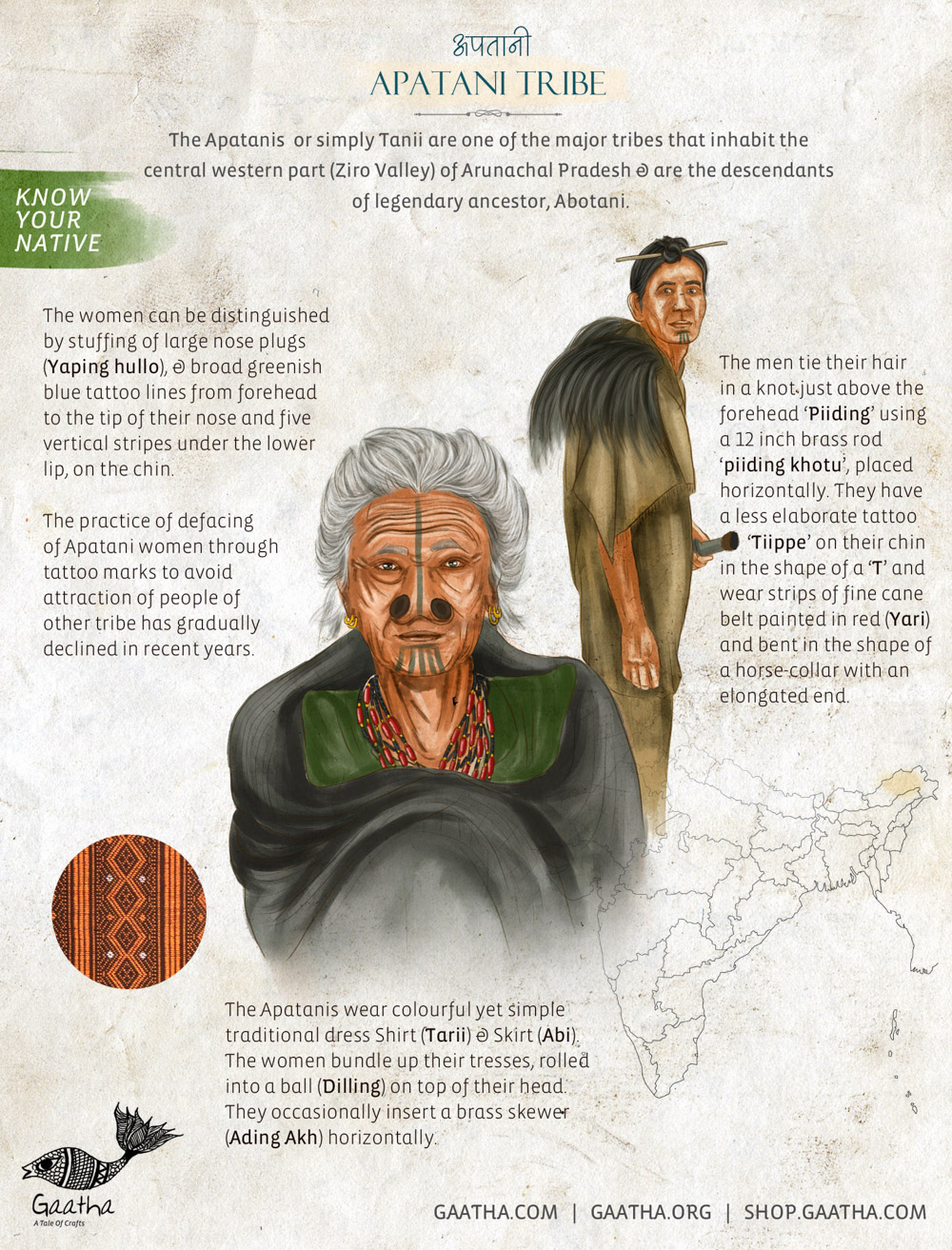
They say beauty has a price to pay and the price is paid by men & women both, in strange ways though, when it comes to the Apatanis of Arunachal. One of the most distinguishing features of this tribe, their tattooed faces and huge nose piercings studded with wooden blocks started off as an uglification process. The tribe recollects certain mythical discourses related to this ritual. The most popular story asserts the Apatani girls as very beautiful, who were constantly made victims of abduction by other tribesmen. Therefore, in order to protect their honour and label them, the tribe decided to carve tattoos on their faces, as a process of ‘uglification.’ The Apatani men fought frequently with their neighbouring tribes and died during those feuds. They returned to their homes as spirits to unite with their wives, who were unable to see them. Feeling ignored, the spirits caused havoc. Frightened, those families called the Shaman, the Apatani priest, who informed them about the cause of those
agitations. As a remedy, the priest advised the women to ink their face and make them self unrecognizable wherefore the spirit won’t be able to recognize them and will depart.
The tribe is mainly divided into two groups, Mura & Mite. The Mites are distinguished by high stature, light skin, prominent nose and deep-set eyes, whereas the mura have more mongoloid characteristics.
Aptanis are among the few tribes in the world who continue to worship nature and their most distinguishing feature is the ingenious care they place in transforming their entire valley into a veritable garden; every piece of land is beautifully used. The Apatanis have developed a Indigenous Knowledge System, while inhabiting in the remote forested areas of Ziro valley, closely linked with nature. As the Apatanis recognize the value of each plant, they follow traditional conservation practices. The values attached to these plants from ritualistic point of view play very important role. Their cultural landscape has been tentatively enlisted as World Heritage Site by UNESCO.
BAIGA
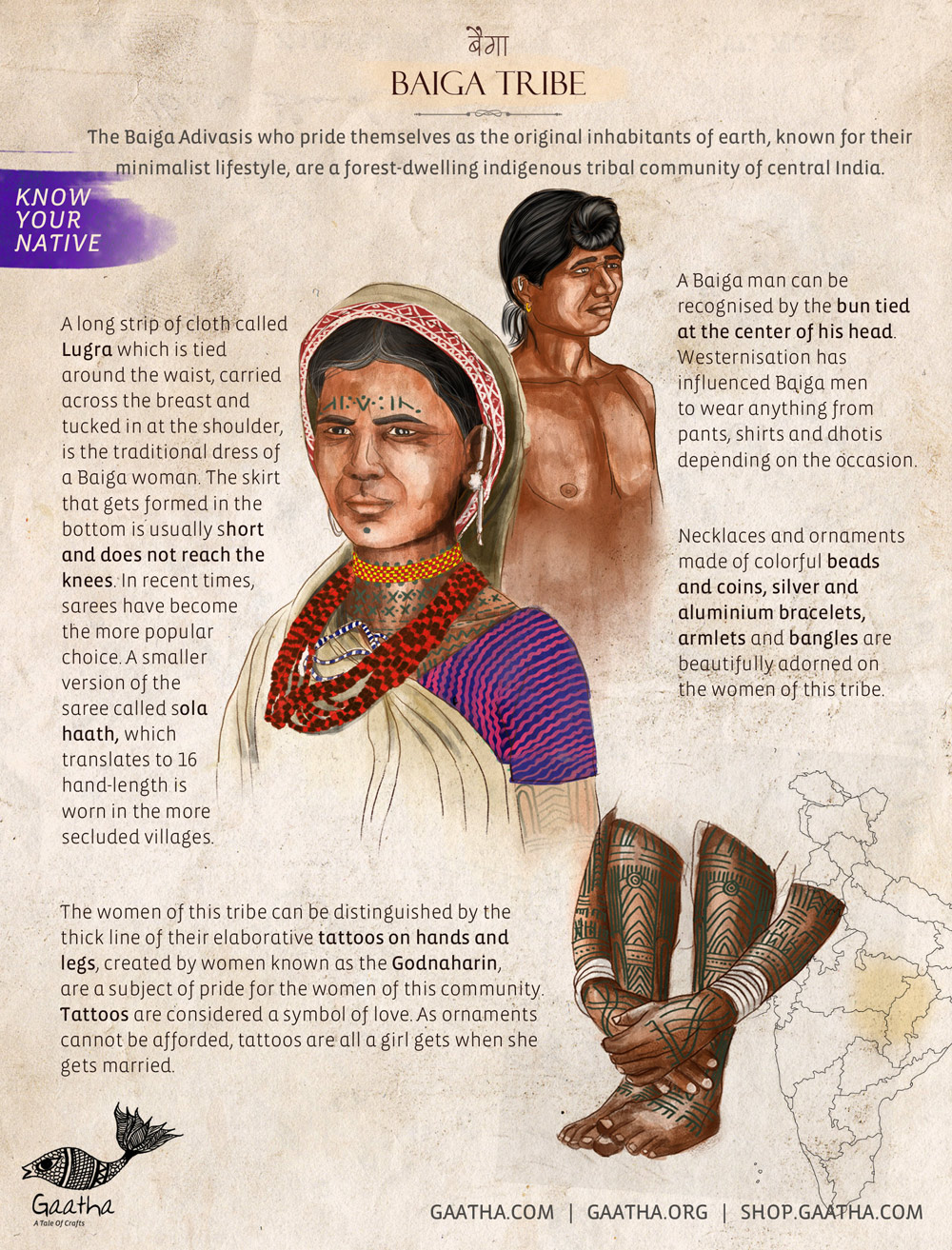
Dominantly residing in Madhya Pradesh & chhatisgarh, the Baiga tribe got it’s name from the Hindi word ‘Vaidya’ (healer) because of their profound knowledge about the medicinal and healing properties of the various species of flora and fauna found in the forests. The Baigas which are a sub-caste of Gond tribe are further divided into sub-castes like the Narotiyas, Bharotiyas, Reimeina, Kathmeina, Kodwan, Kundi Godwen and Nagar.
Unattached to their material possessions, minimalism and simplicity of the Baiga tribe has always been a point of highlight while discussing the history of this community. Each Baiga-God carries a positional power and designation that is inseparably linked to the God hence, Baigas do not worship Gods as ubiquitous supreme lords.
Festivals and dancing also hold a significant importance in the Baiga culture, Karma dance being the most important dance from with others like, Baigani, Saila, Bhilma and many others. They have separate dances for men, women and all of them together. Four to five Mandar/dhol drums are played around the necks of Baiga men which make the most common instrument to the Karma dance, around which, generally, colourfully decked Baiga women dance in a circle.
Mahua (local alcohol) is an integral part of their wedding ceremony, during which the groom’s family brings around 40 liters of alcohol to the bride’s house while the guests move around in circles consuming alcohol and blessing the married couple. The couple then travels around the village praying to all the gods and goddesses. Polygamy is not uncommon.
BHIL
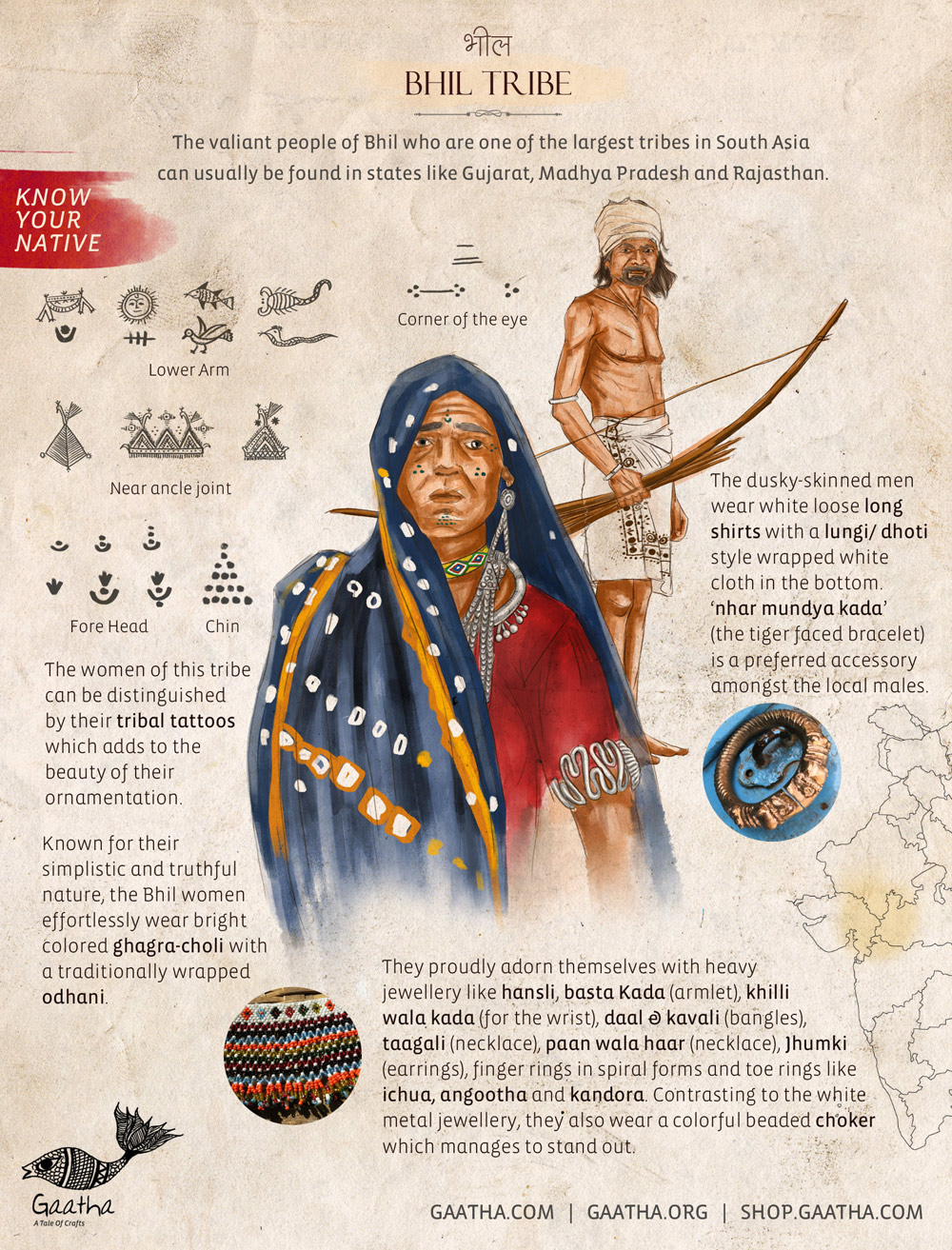
Many years ago, Bhil kings permitted many innumerable immigrants from the plains to settle in the mountainous regions, who later in return fought and rebelled against the Mughals, Marathas and the British to safeguard their rule. The name “Bhil” was derived from the word billee, which means “bow“. The men always carry their bow and arrow with them, which has been their characteristic weapon for years. Traditionally the Bhils lived by practising shifting, cultivation, hunting and gathering in the dense forests that used to cover the terrain. A week before Holi, a festival called ‘Bhagoria‘ is celebrated by the Bhils of Jhabua district in MP. It is an occasion where young unmarried men and women come exquisitely groomed in order to propose to their matrimonial preferences. They apply ‘gulal‘ (red holy powder) on the face of their beloved, in the presence of their entire village and if the latter is also mutually in love, the gesture is returned, followed by the ceremonial act of eloping. Once the boy and girl are back from their romantic adventure, the elder folk gear up to get the young couple married.
The Bhil people love their independence and often indulge themselves in drama, music, dance, festivals, etc which is a large part of their innately rich culture. Their illustrious homes are plastered every year and clay relief work, mittichitra, paintings, etc reveals their distinguished sense of aesthetic. People of Bhil tribe have been under a severe threat because of the Sardar Sarovar Dam project which is being constructed on the lands where Bhils live. Re-settlement plans have been discussed but they remain incomplete.
DHANETERA JAT
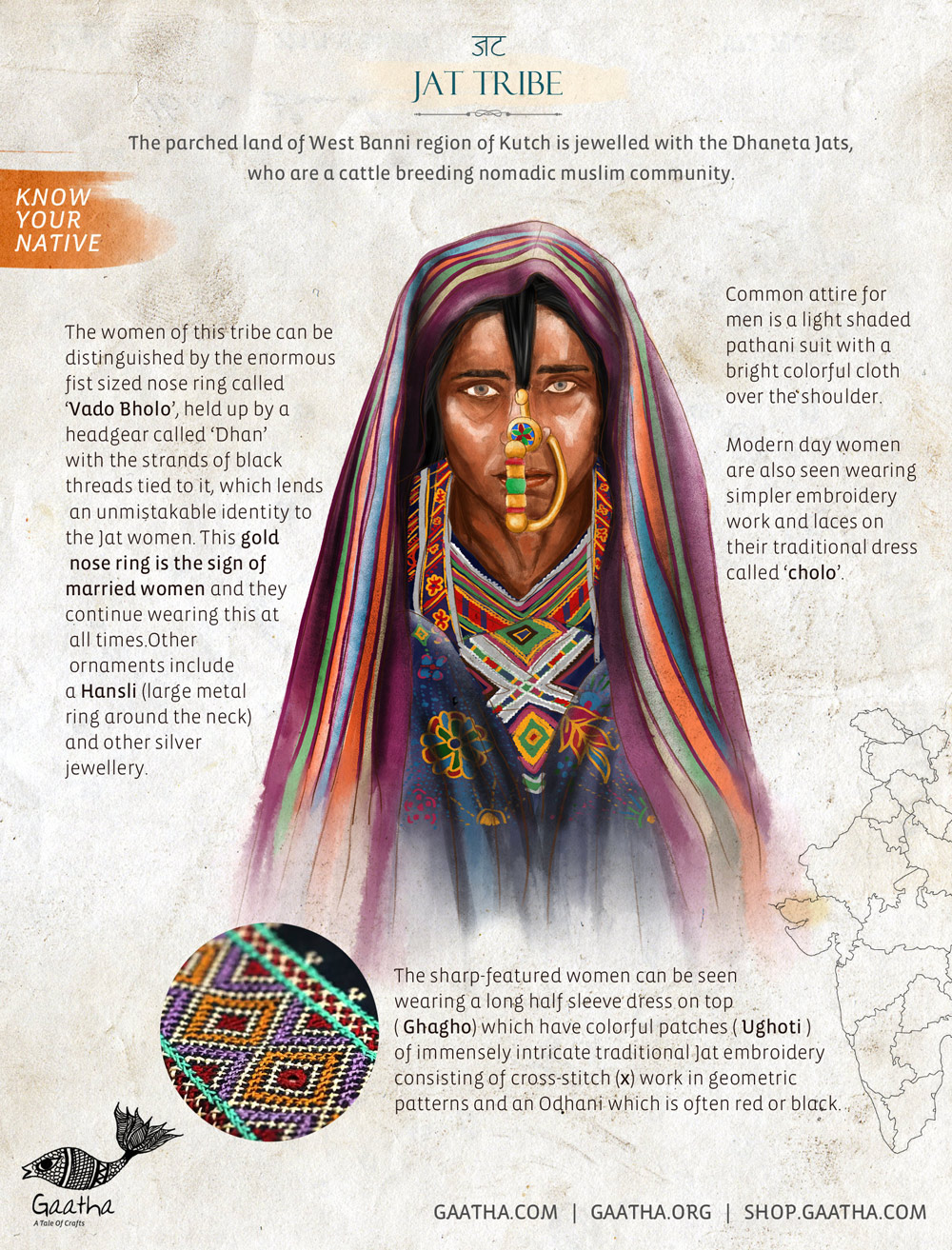
The spellbinding Jat community are a part of the Maldhari pastoral nomads who breeds the most superior kind of buffaloes and camels. Keeper (dhari) and animals (mal) literally translates to keeper of the animal stock. They are believed to have migrated from Persia and Sindh region of Pakistan hundreds of years ago. While the women take care of the houses and fields, the men herd cattle and search for greener pastures through the day. The people of this community are known for being reclusive which makes it difficult to interact with the locals.
RAMNAMI
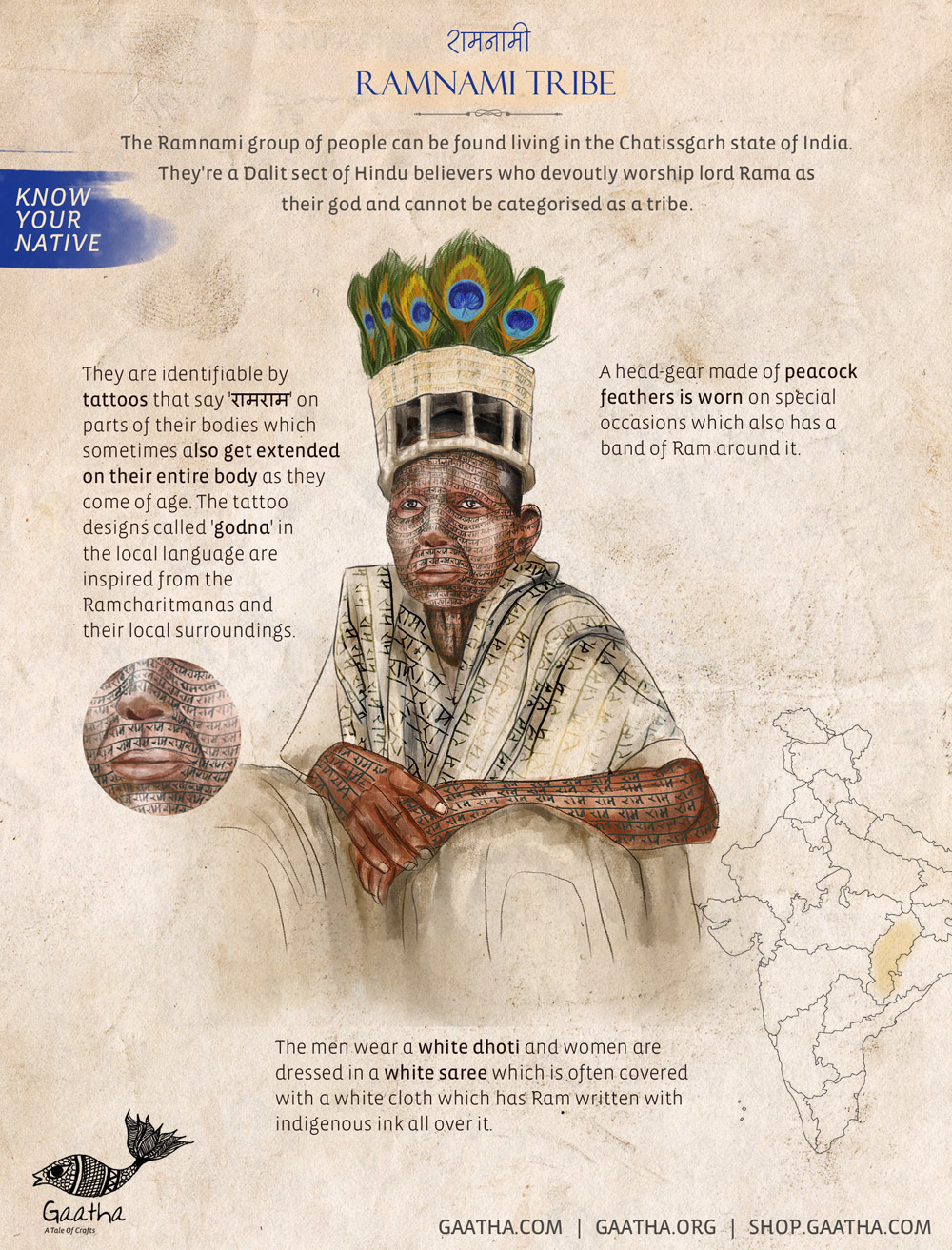
Ramnanai Tribe, Chhatisgarh
Casteism has always been a rampant part of our country’s societal structure. We have come across various protests due the course of time, some of which have been mind-numbingly aggressive and others, rather peaceful. The Ramnami community of Chattisgarh can be considered one amongst those who chose to peacefully resist against the practice of untouchability in India. The Ramnamis covered their bodies, from head to toe, with the name of Ram after not being allowed to enter Hindu temples and worship Hindu gods, and made the Ramcharitmanas a part of their daily lives. It was their way to demonstrate that god can be accessible to everyone and is omnipresent.
The presence of god can faithfully be seen in every aspect of the life of a Ramnami, including their houses, clothes and bodies. They have dedicated their lives to proving that god is everywhere and not just in temples.
GADABA
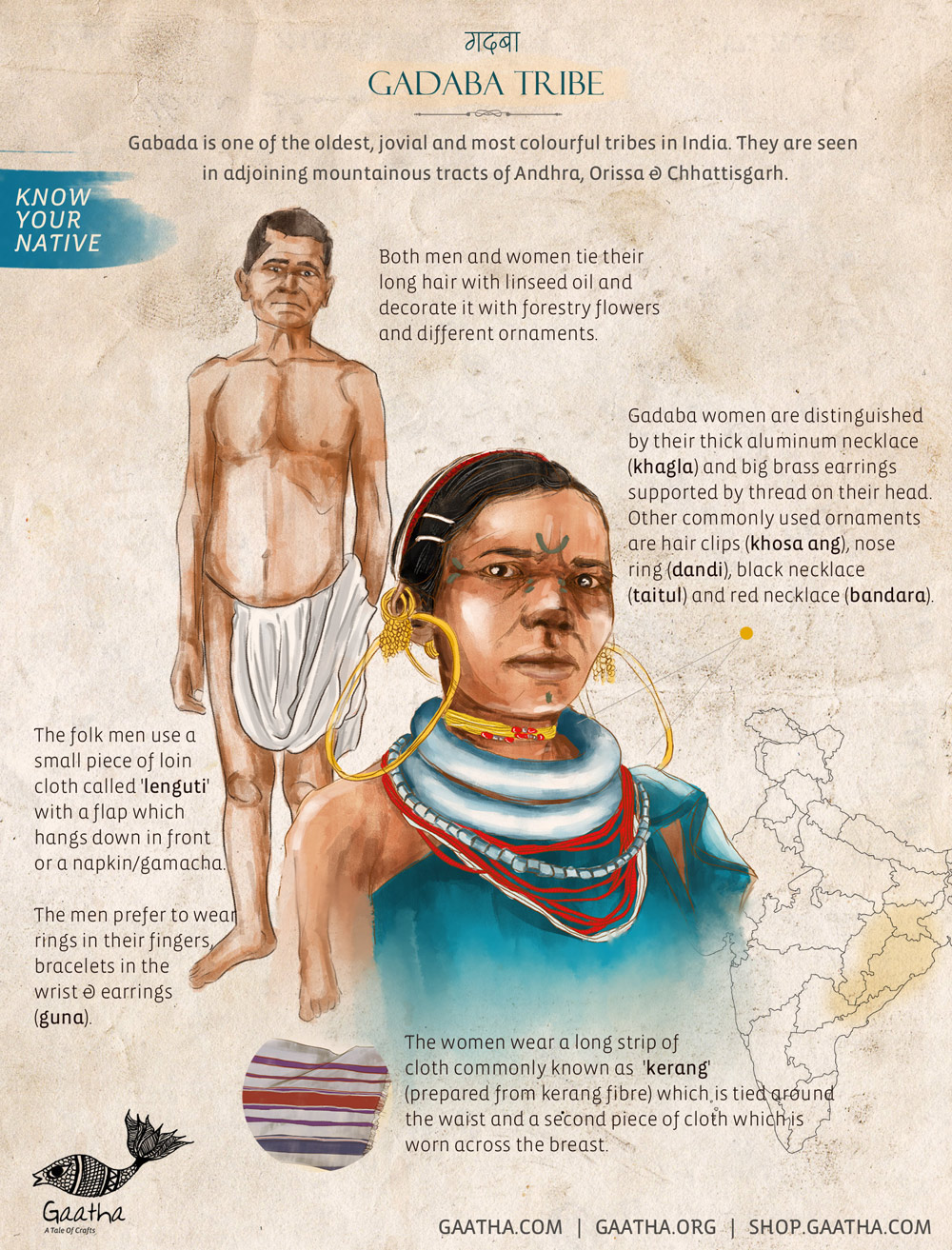
The Gadabas are considered as one of the early settlers of our country and trace their origin to the time of Ramayana. It is believed that their ancestor semigrated from the banks of river Godavari (a river flowing through AP) and settled in Nandapur.
The Gadaba women are fond of wearing several ornaments generally made out of brass or aluminium. Males prefer to wear rings in their finger, bracelets in the wrists and earrings (guna). Women use different types of hair pins and wear earrings, nose rings and finger rings made with coins. Gadaba women wear heavy neck rings that are about a kilogram each. As part of their tradition, it is removed only after their death!
The art of spinning threads, dying them and wearing textiles by the traditional loom reflects the aesthetic life of the Gadabas. The Gadaba Colourful cotton cloth used by the females is manufactured at home by women. These cloths are made with a fibre of a plant, locally known as Kerenga, which is found in the local forest. Gadaba men collect the kerenga fibre from the forest. Then the kerenga fibre is dried and dyed blue and reddish-brown.
